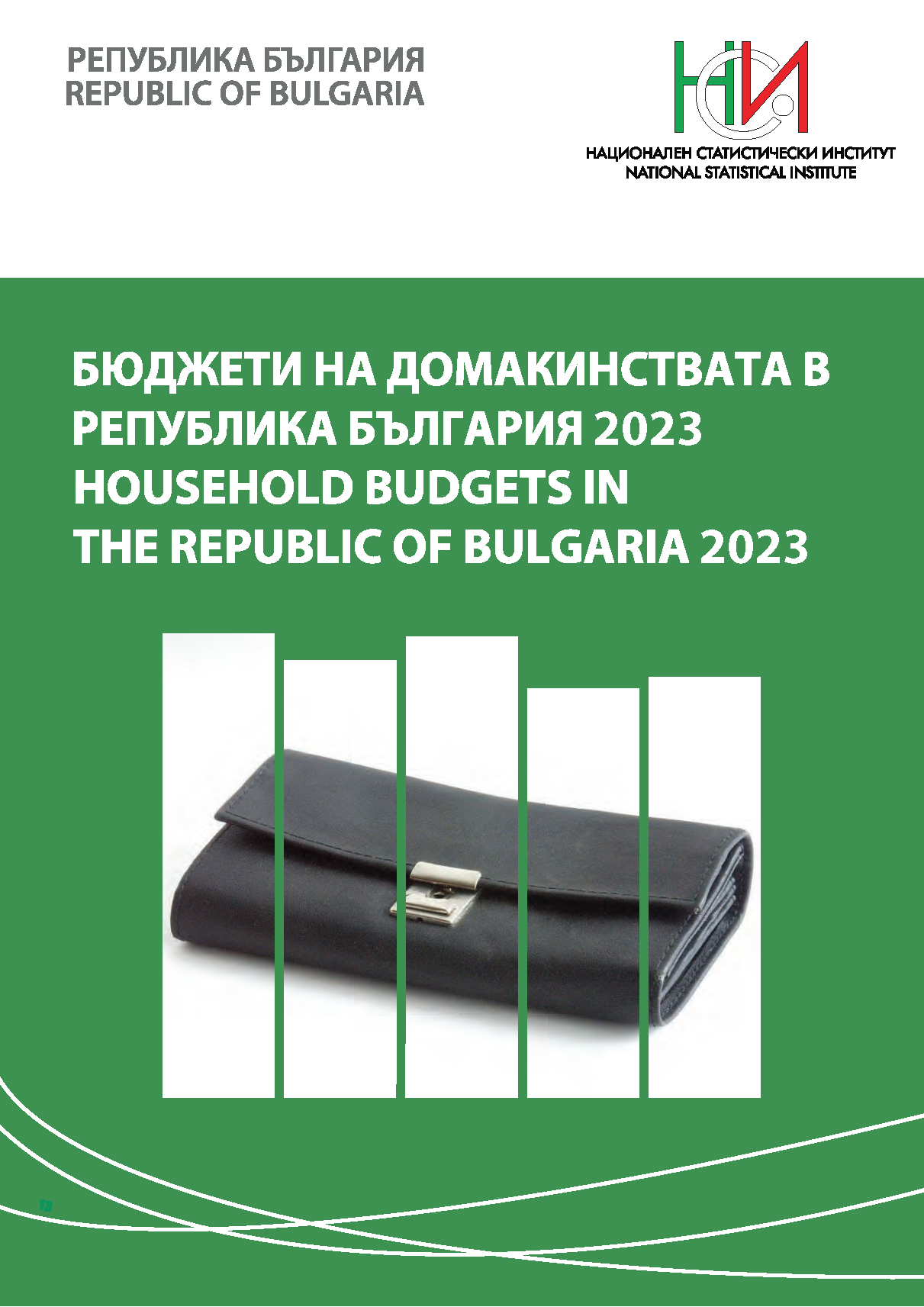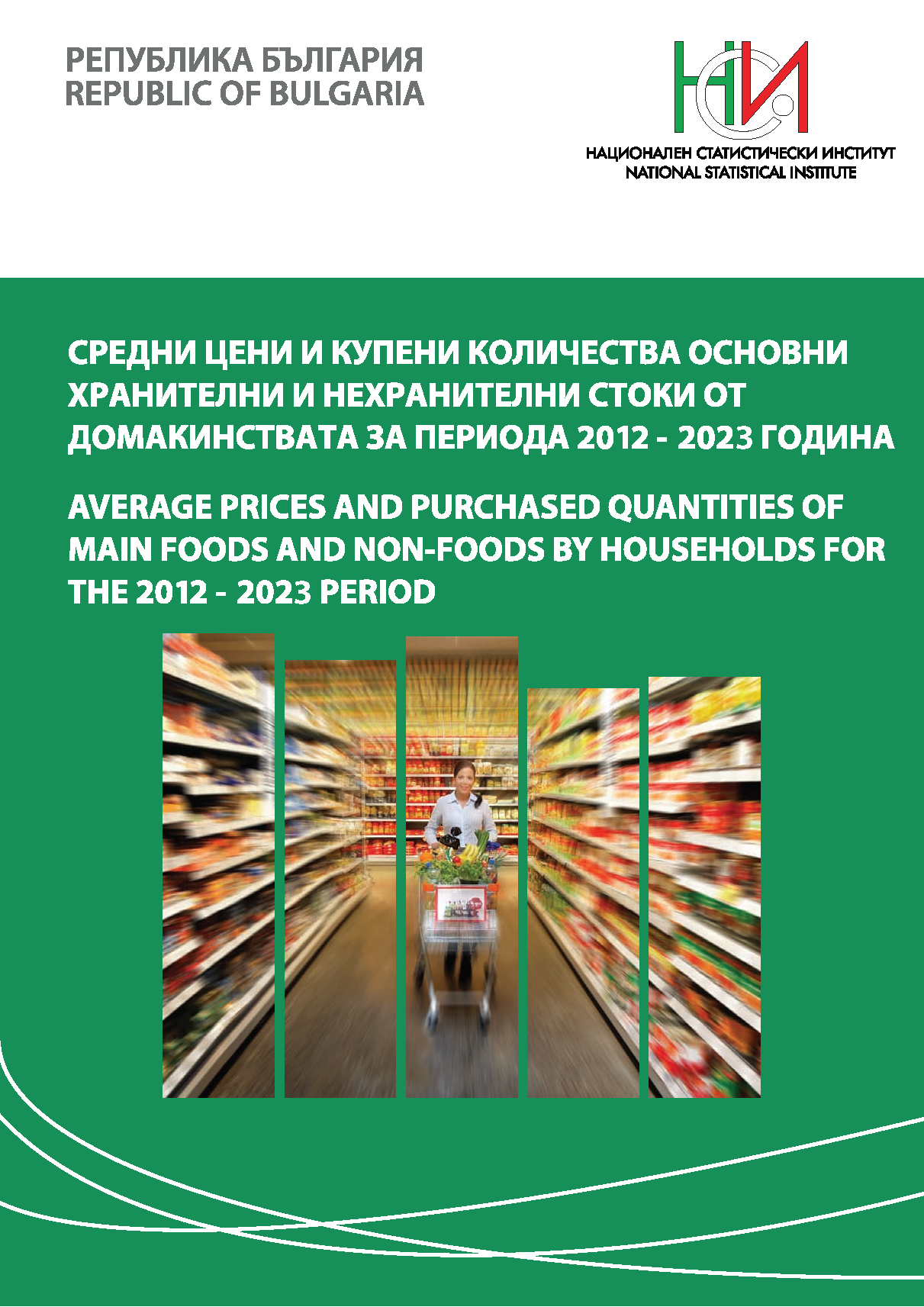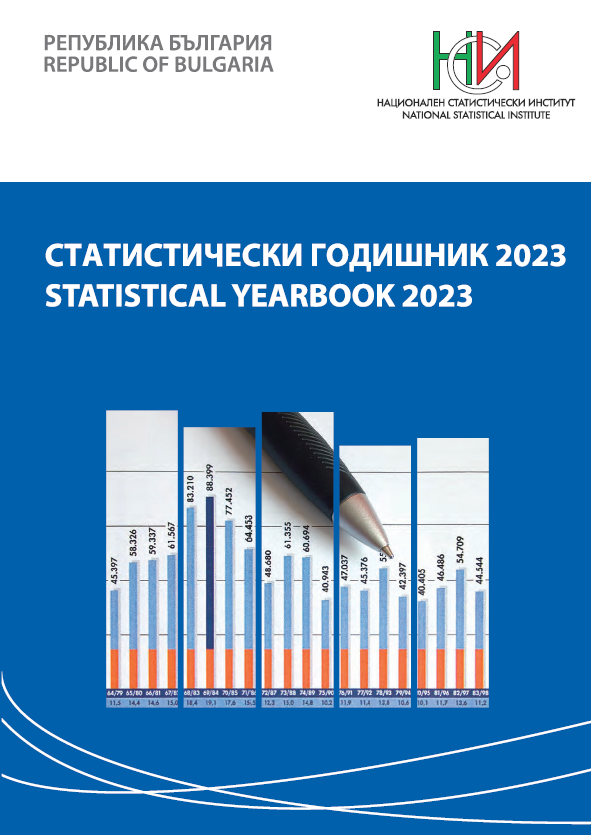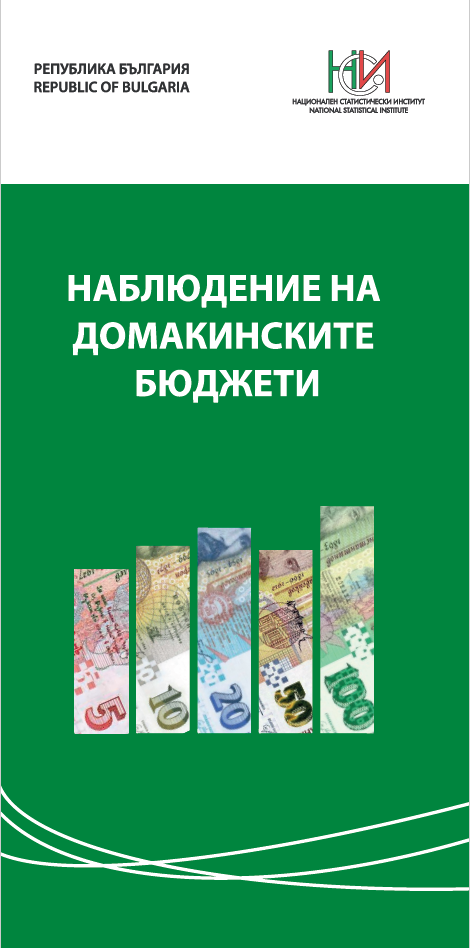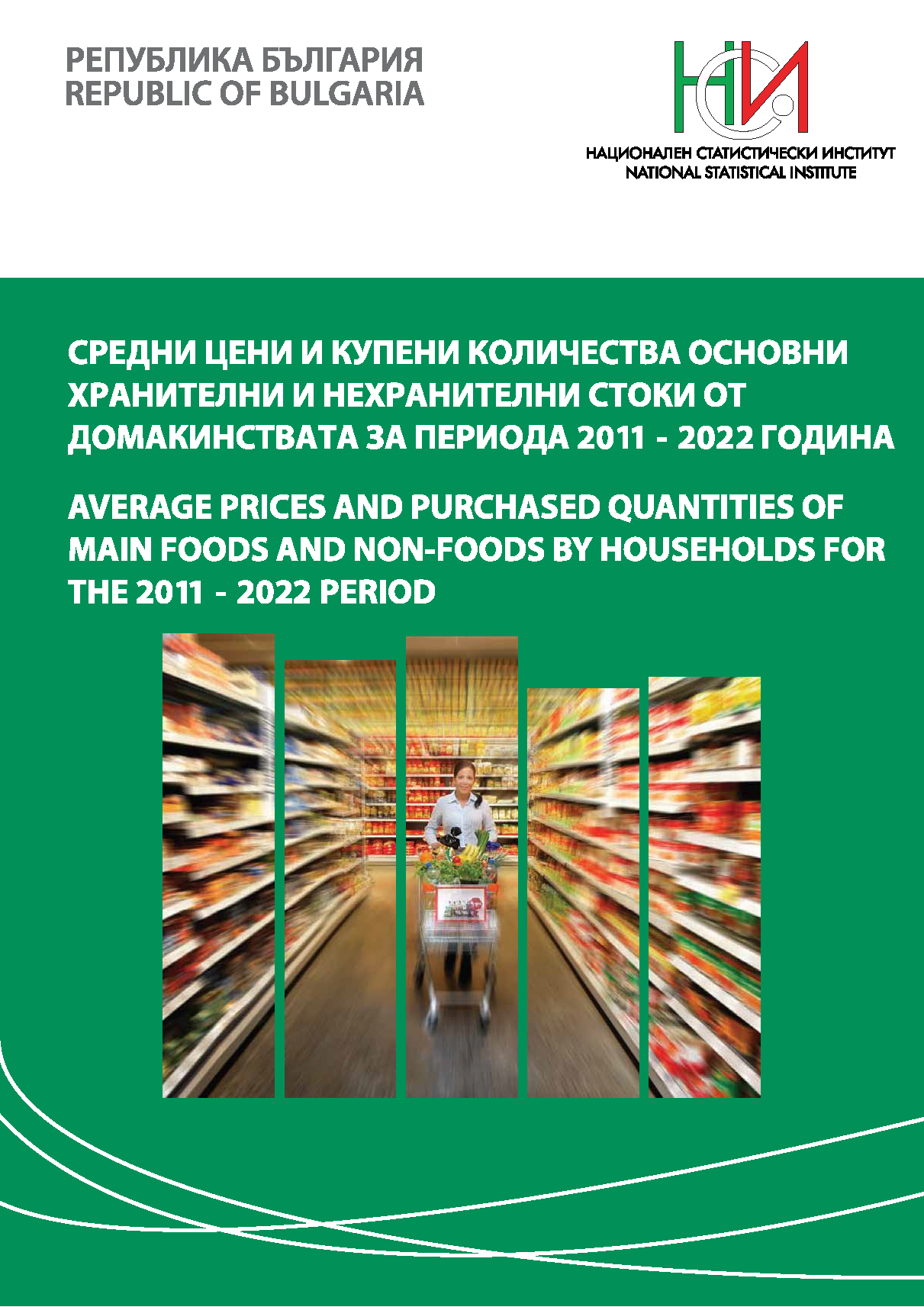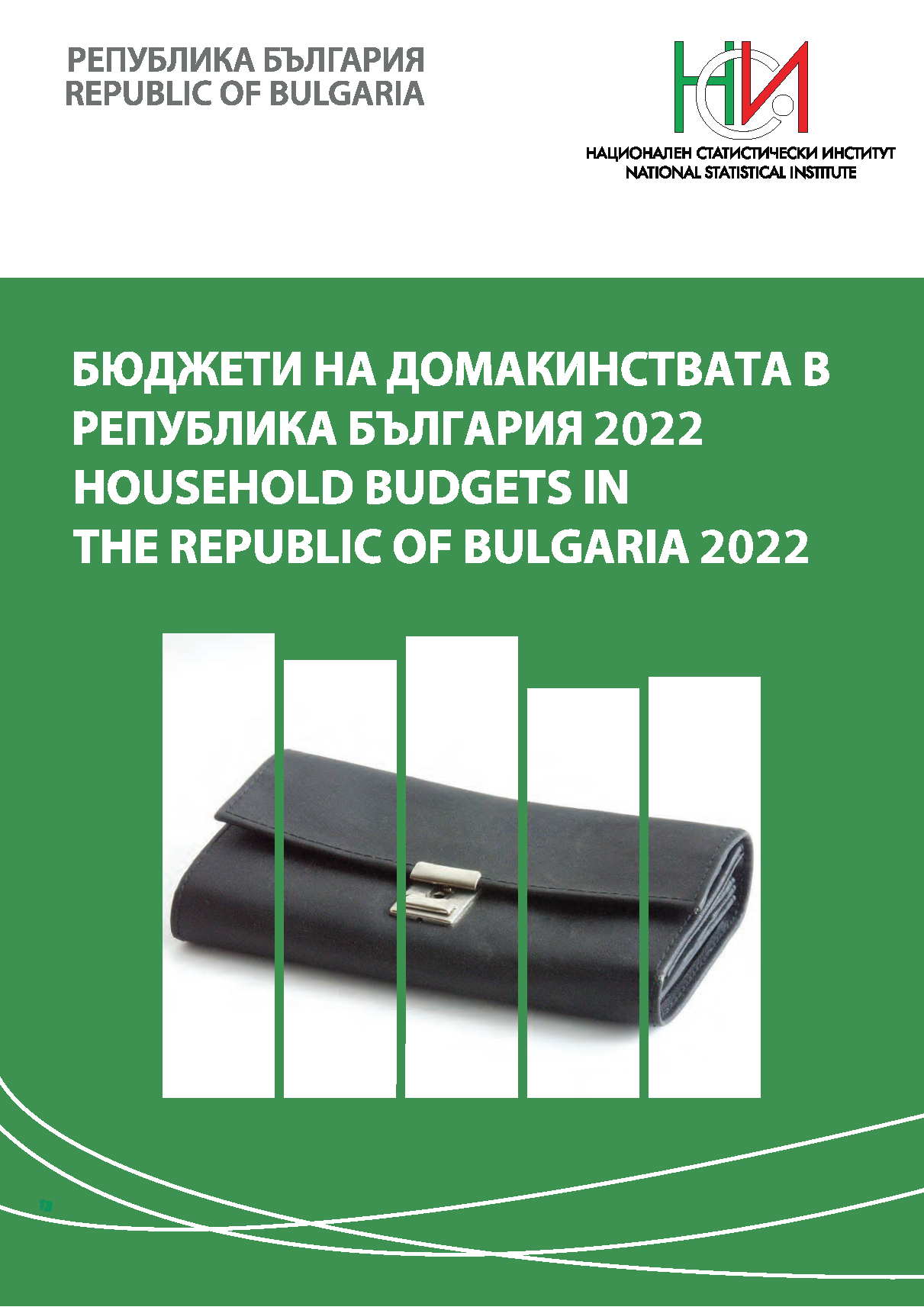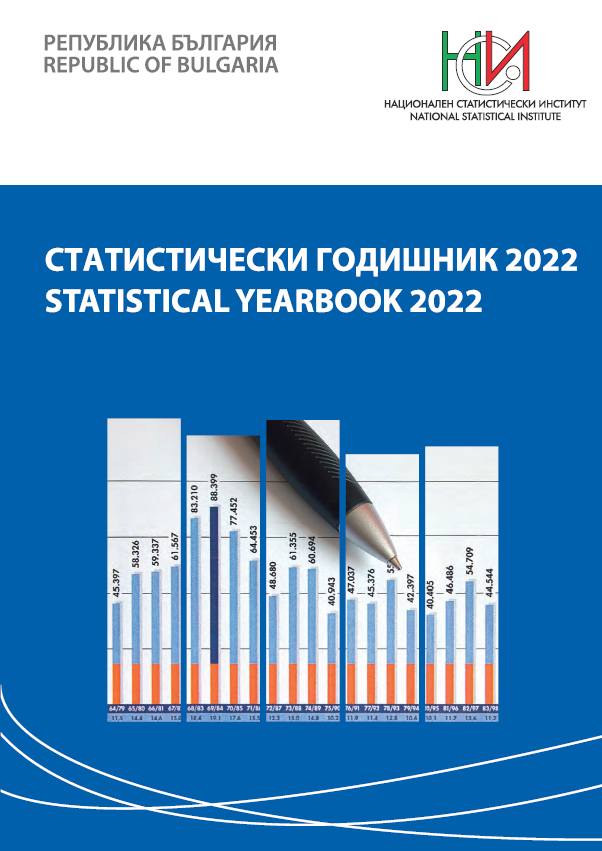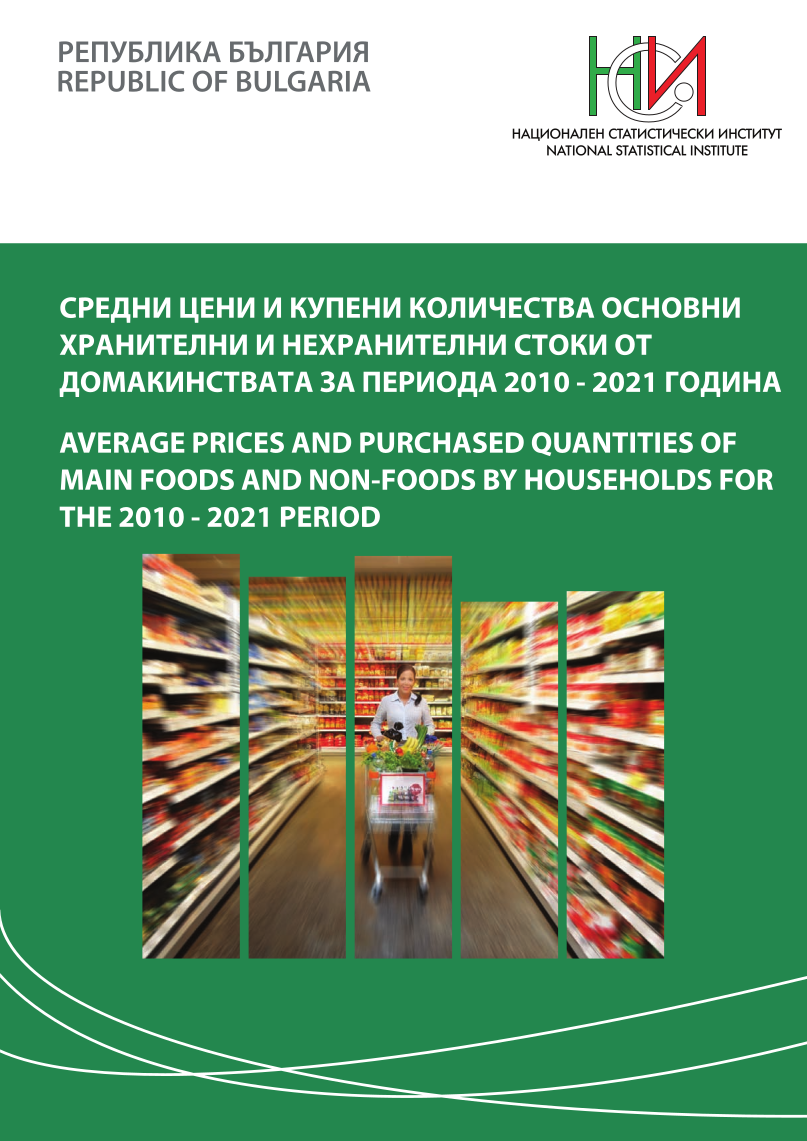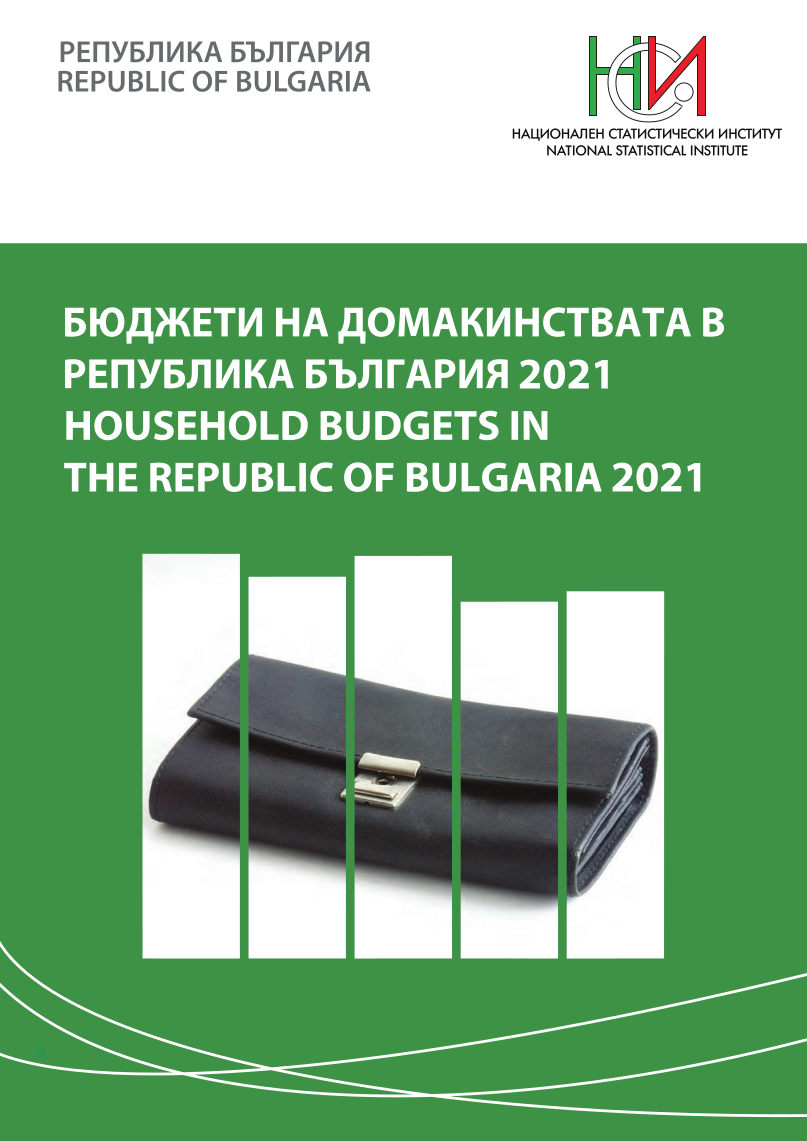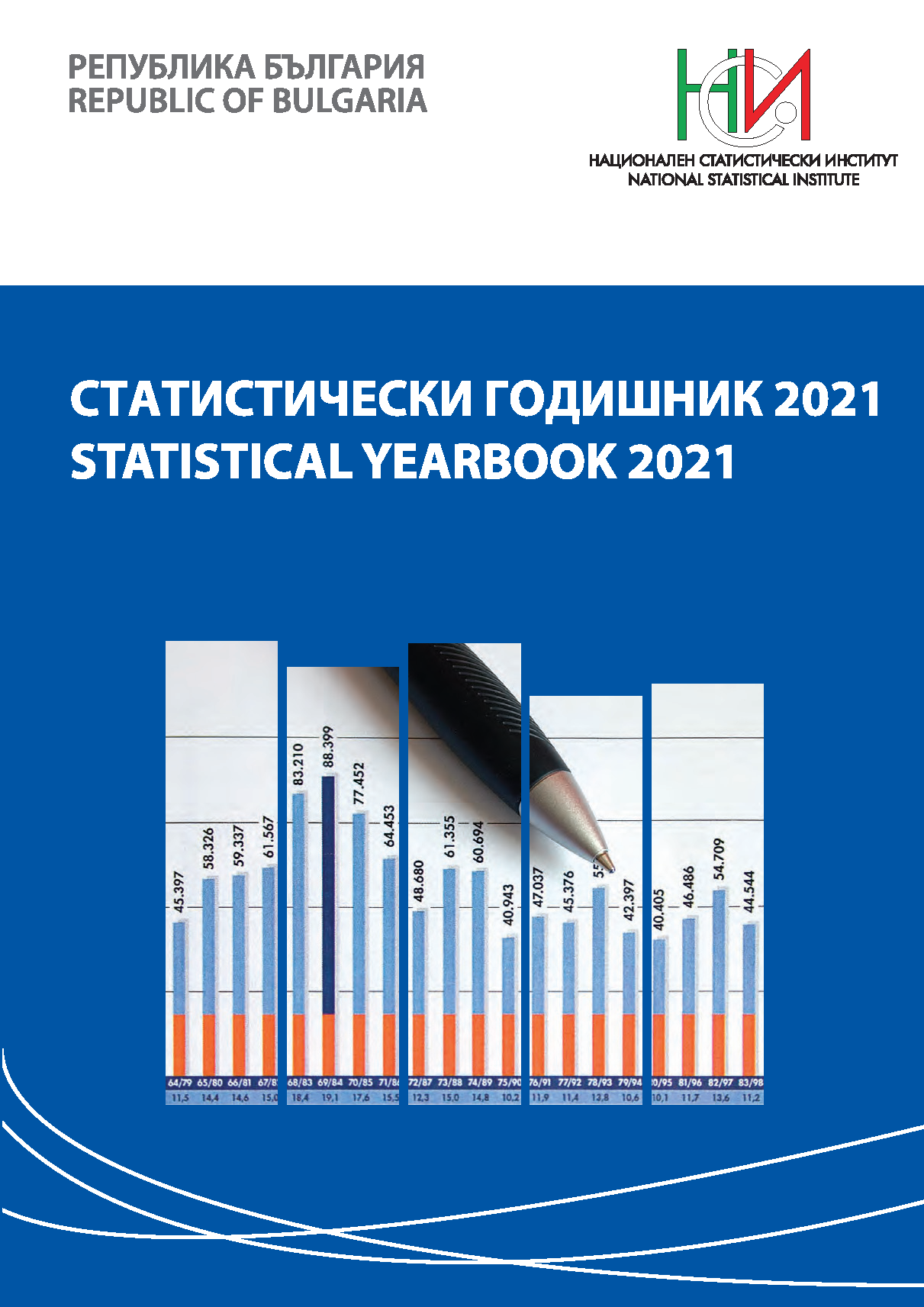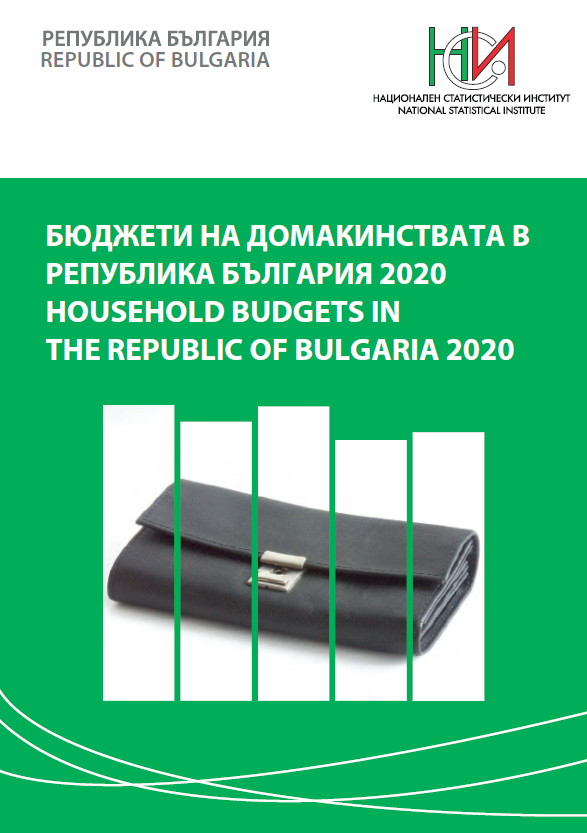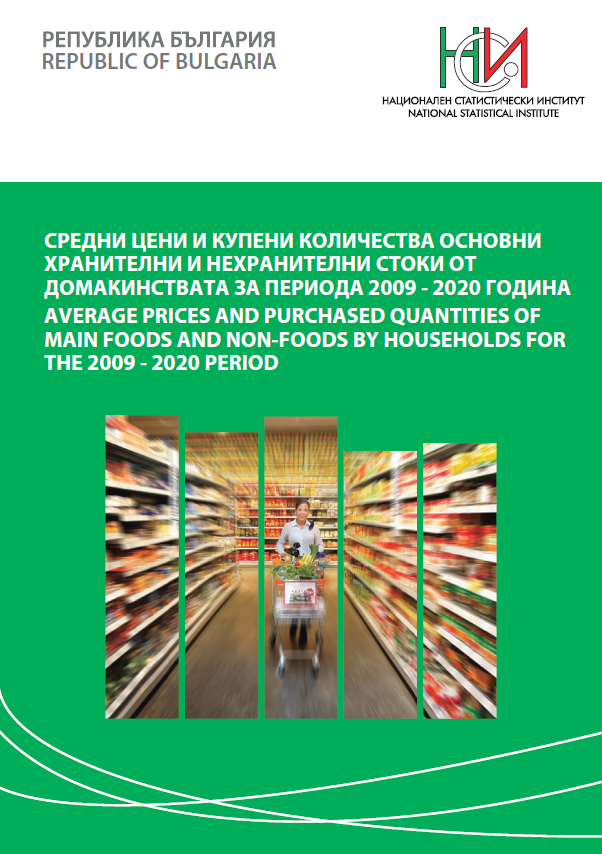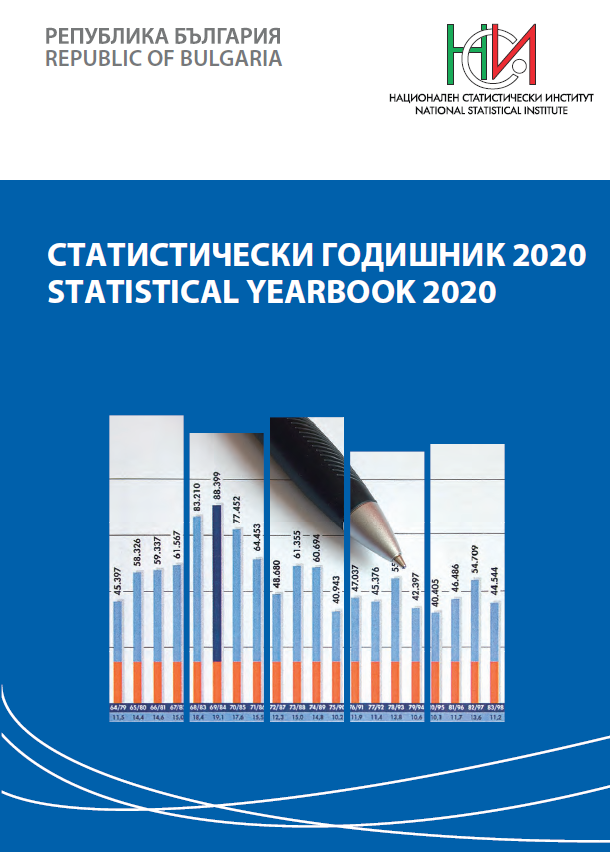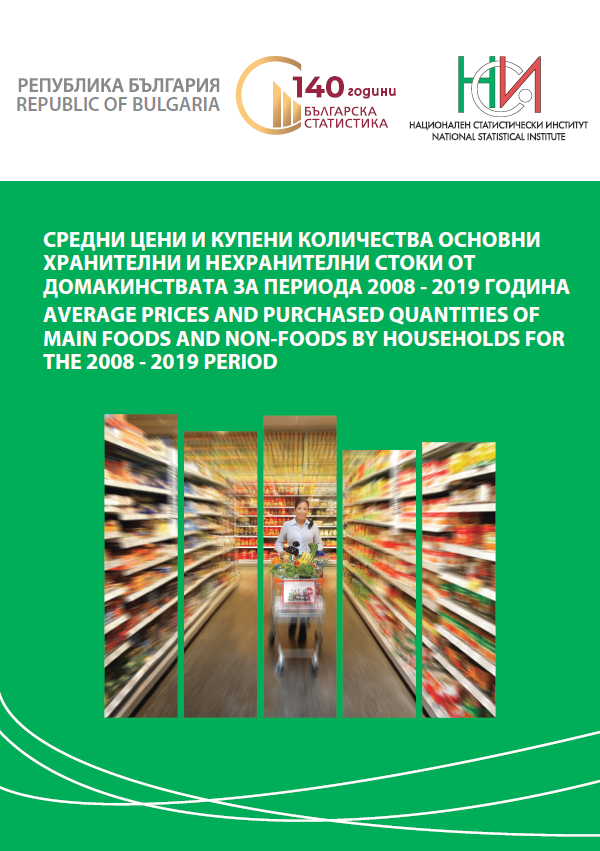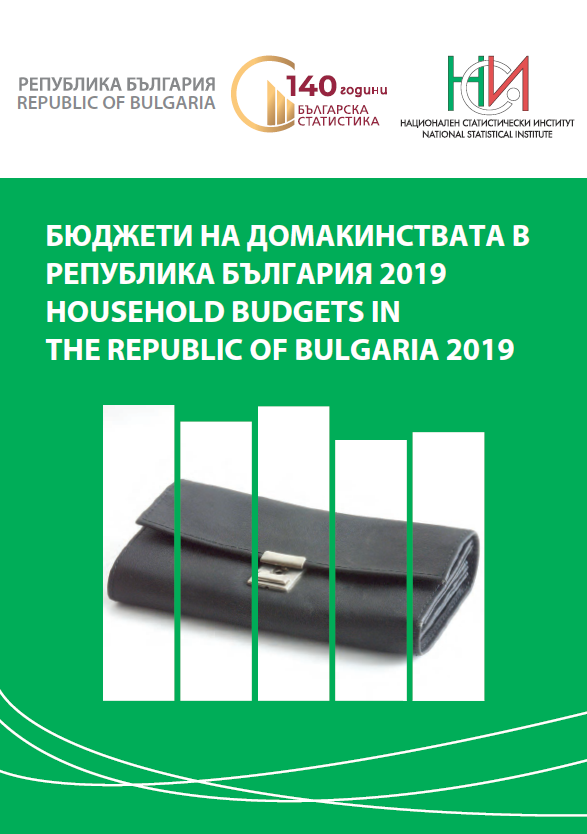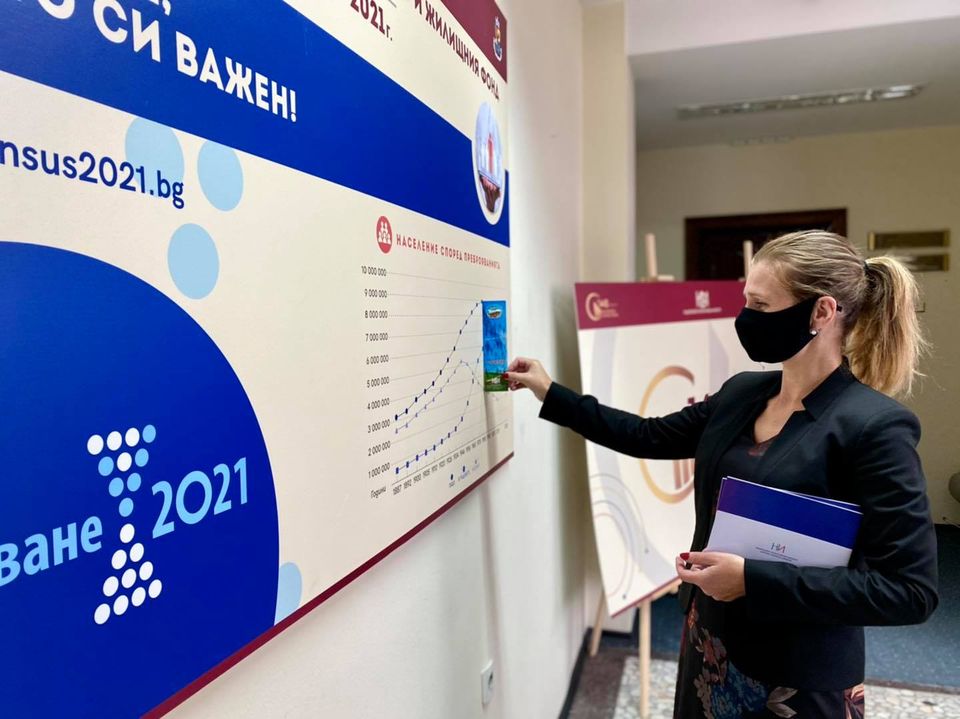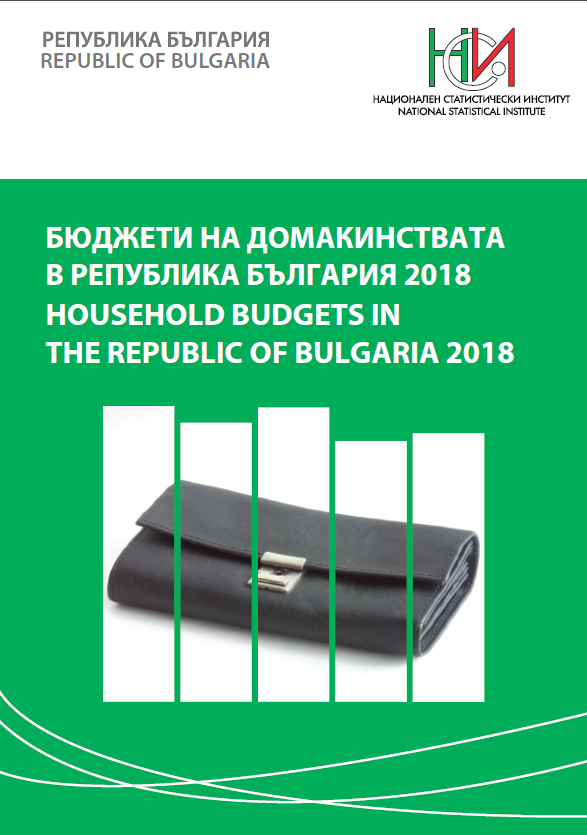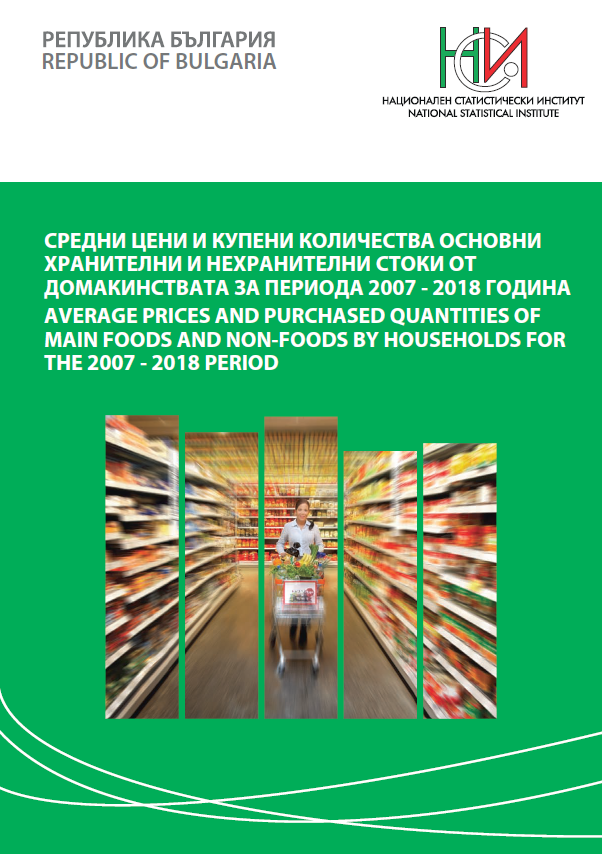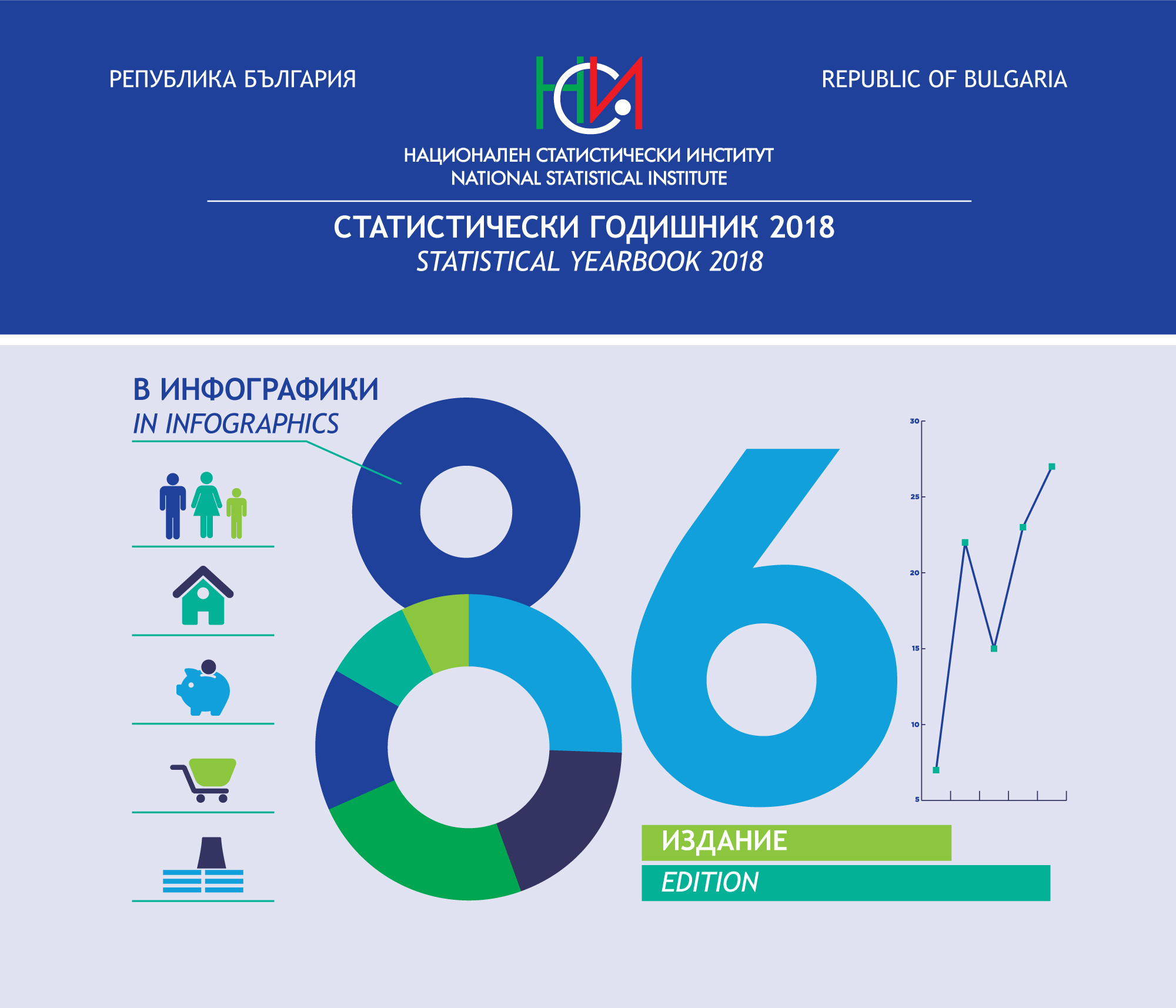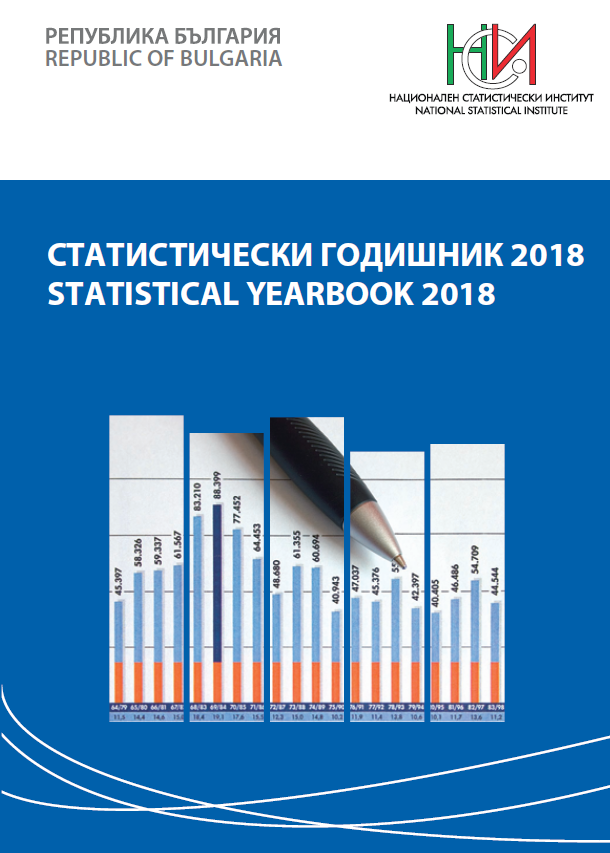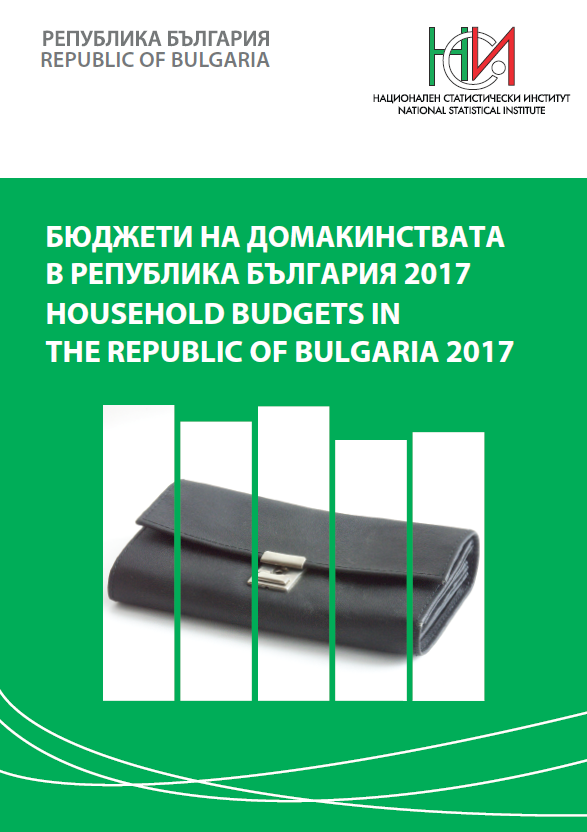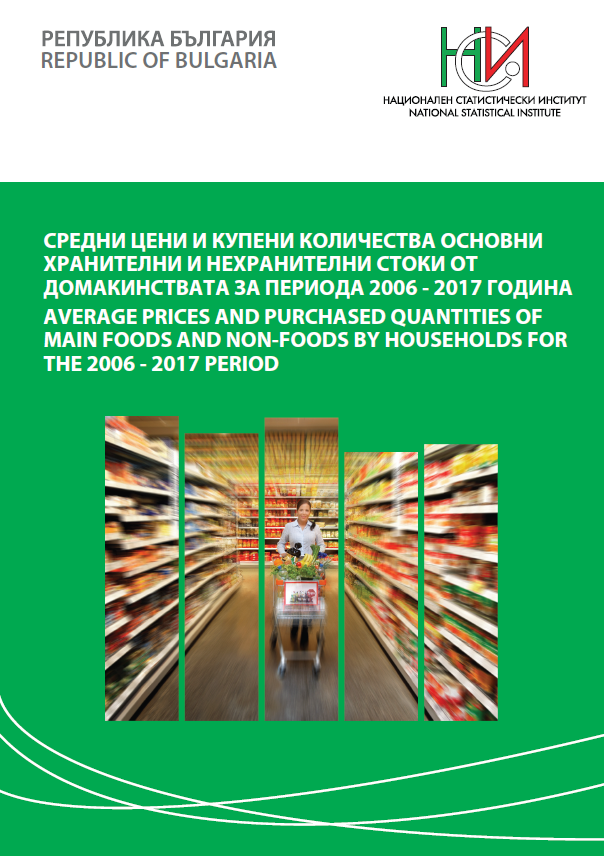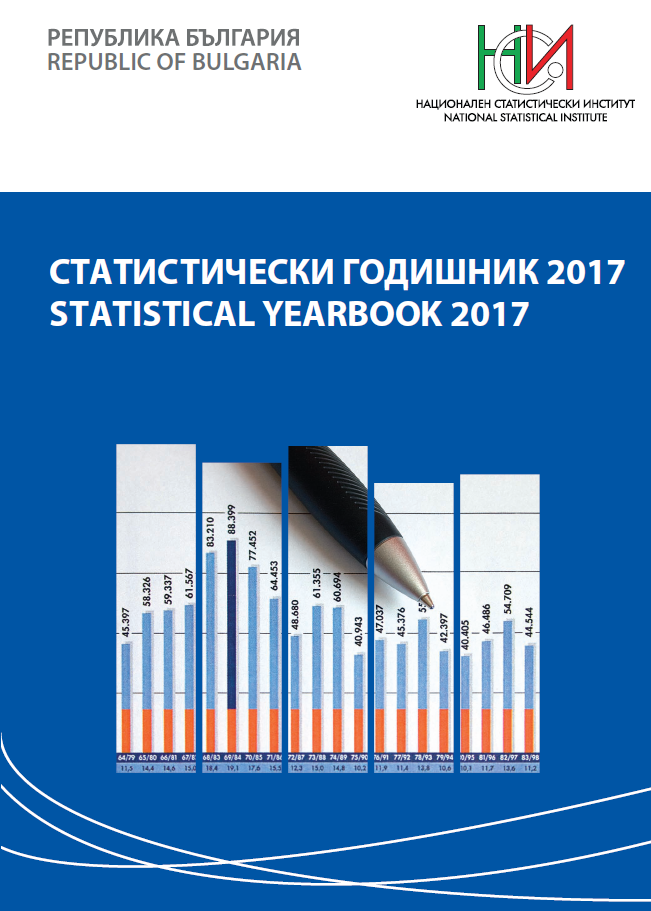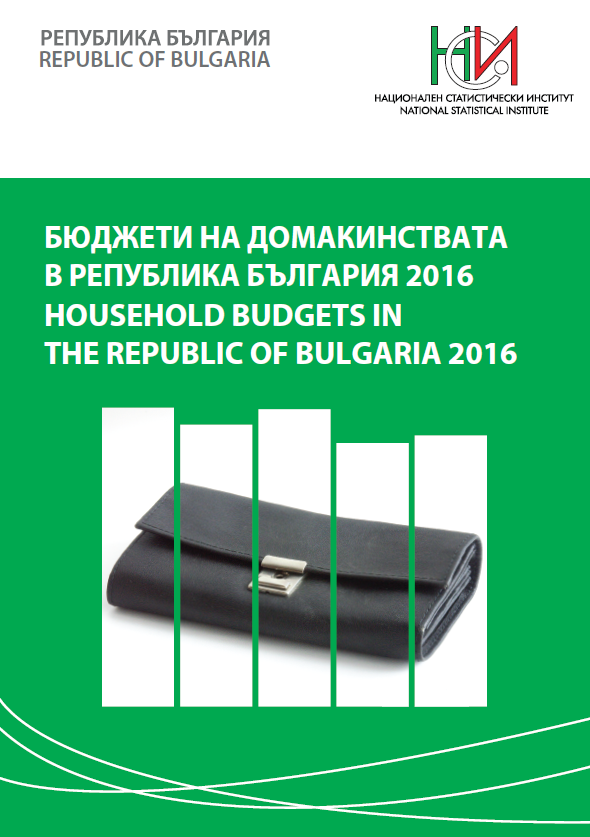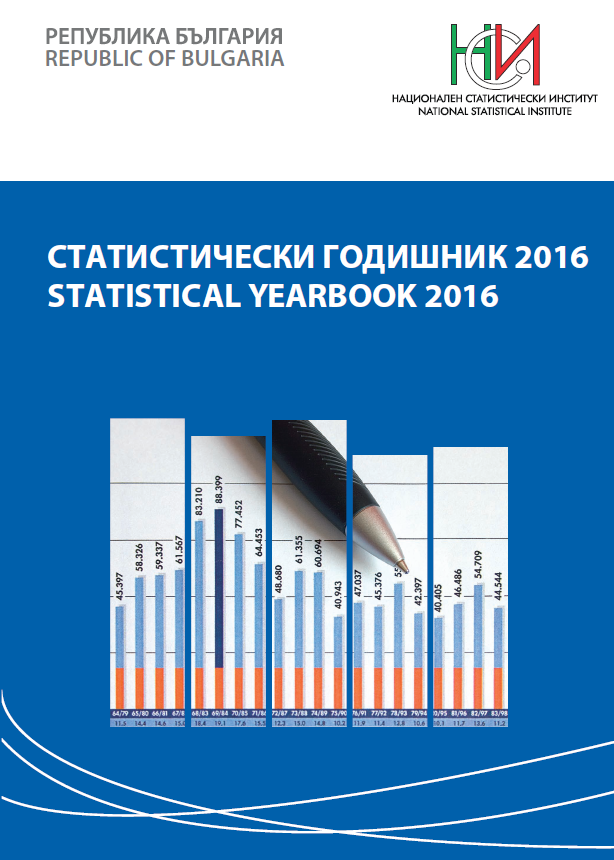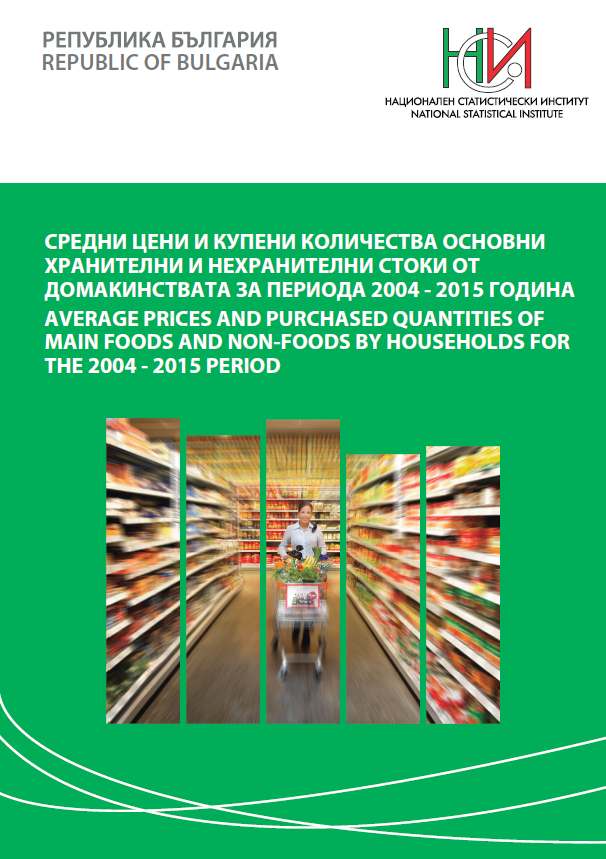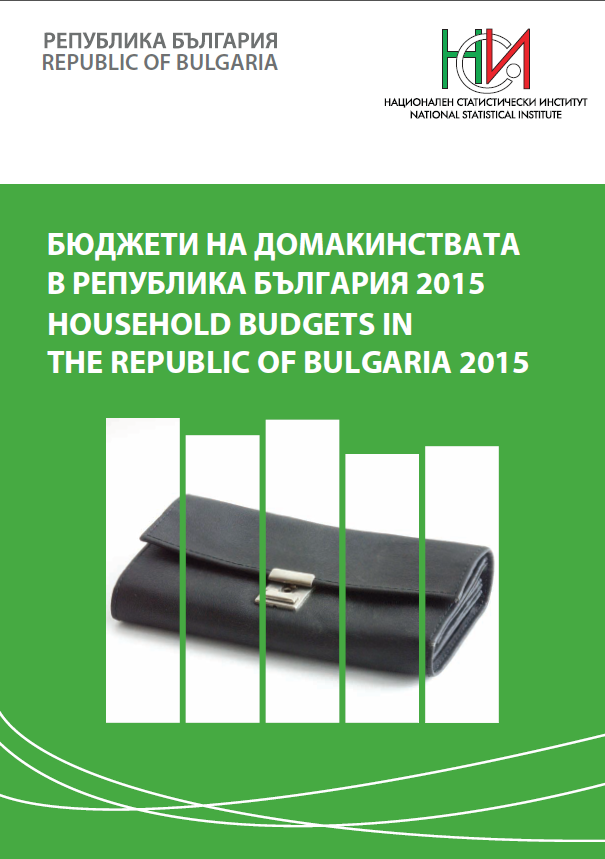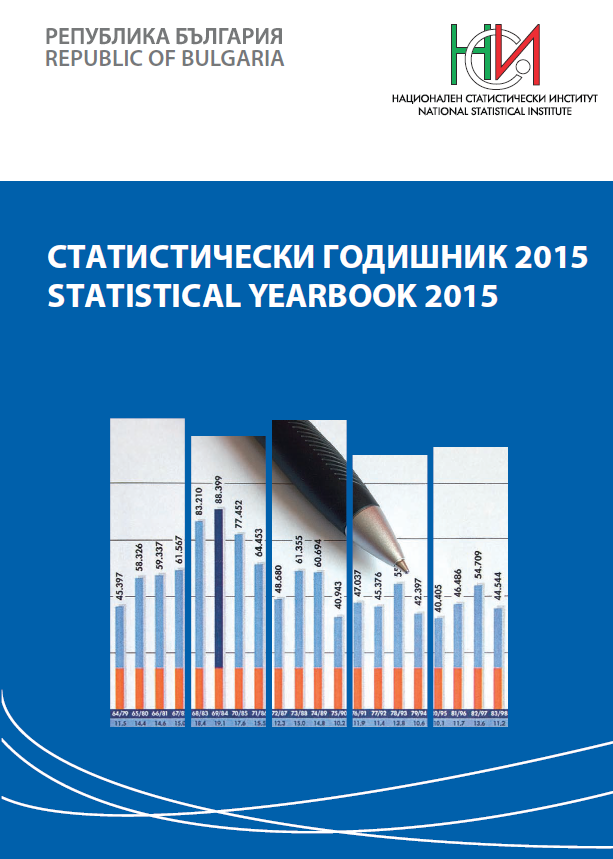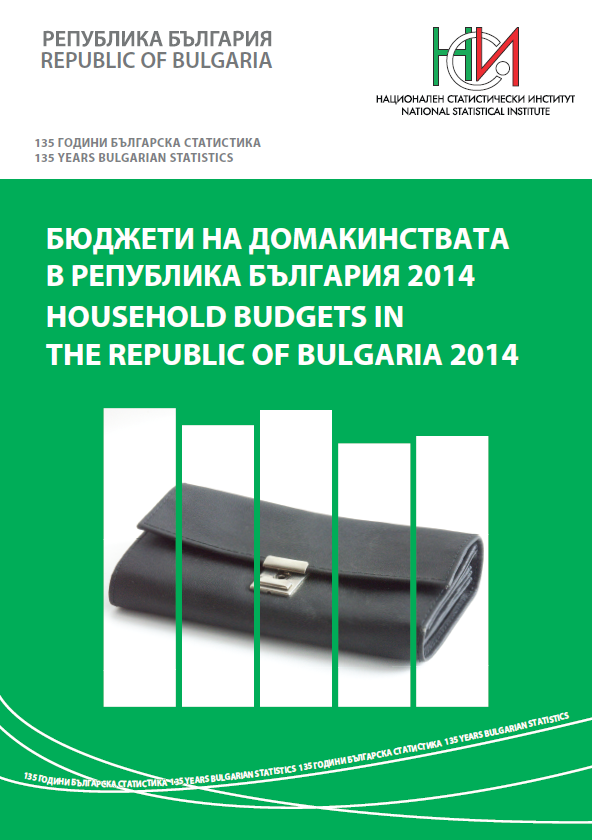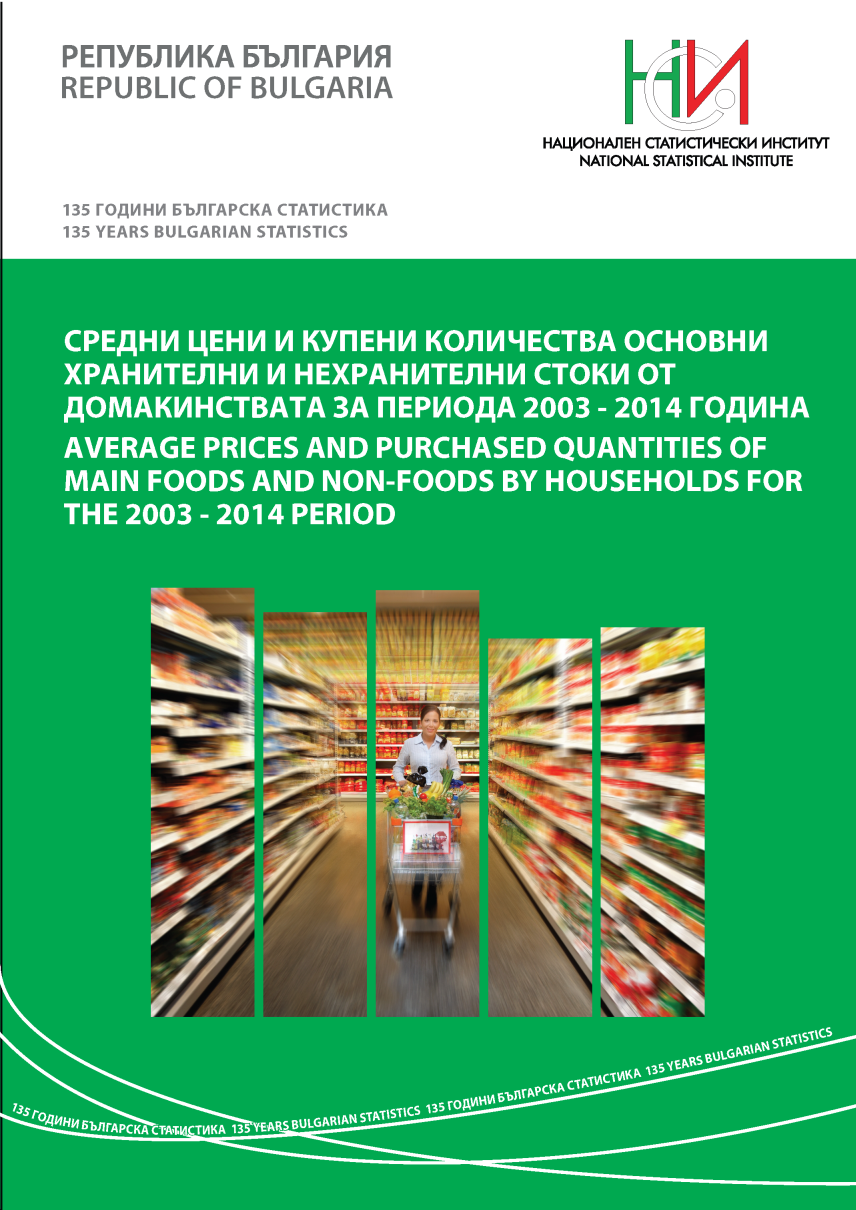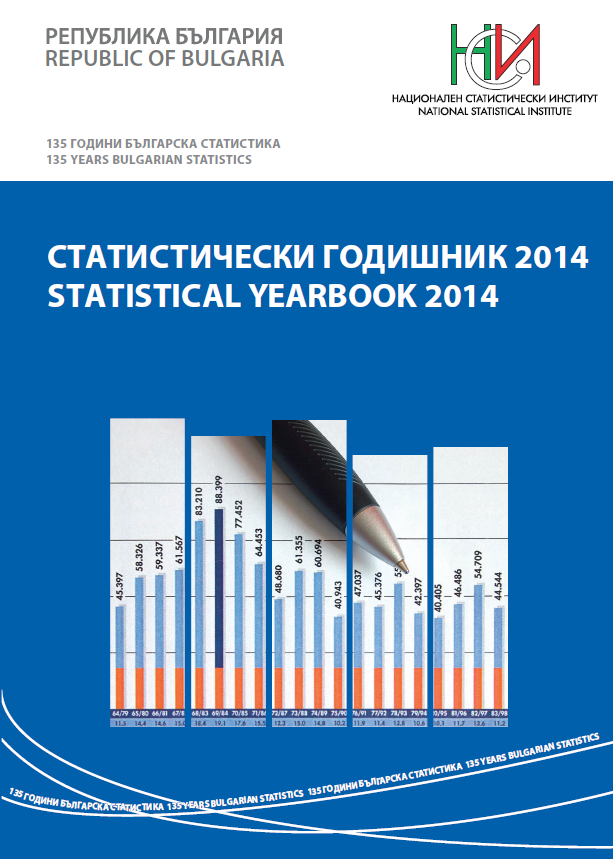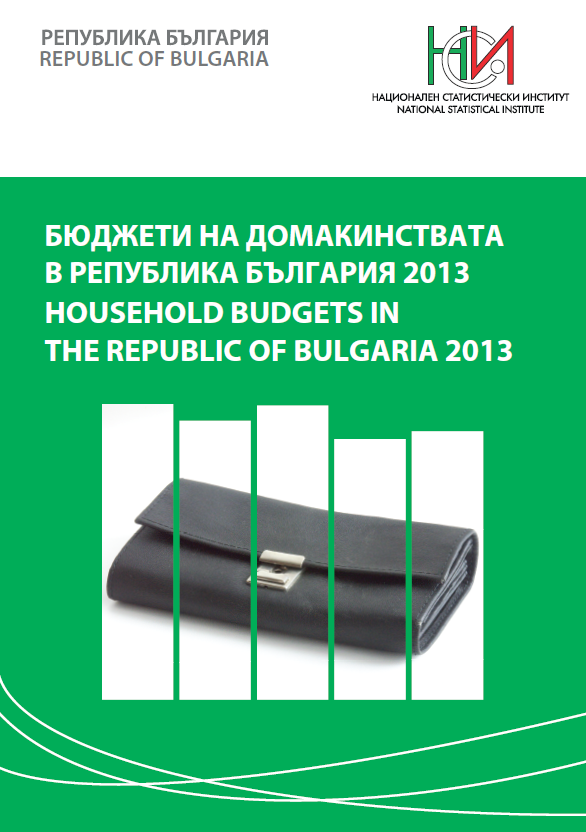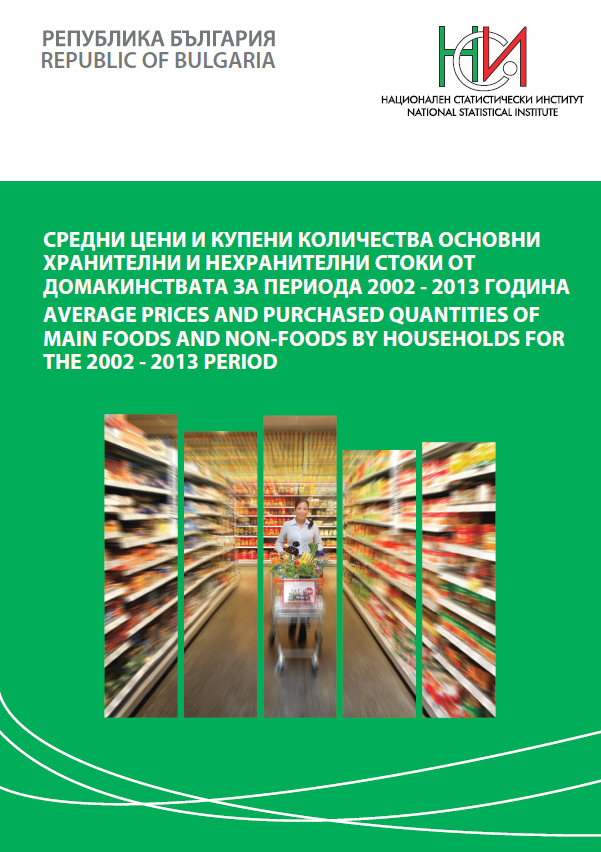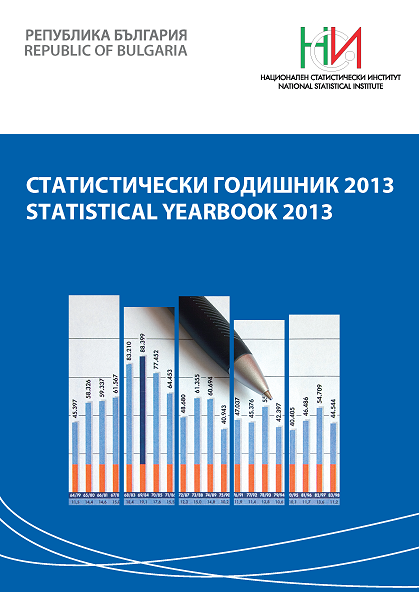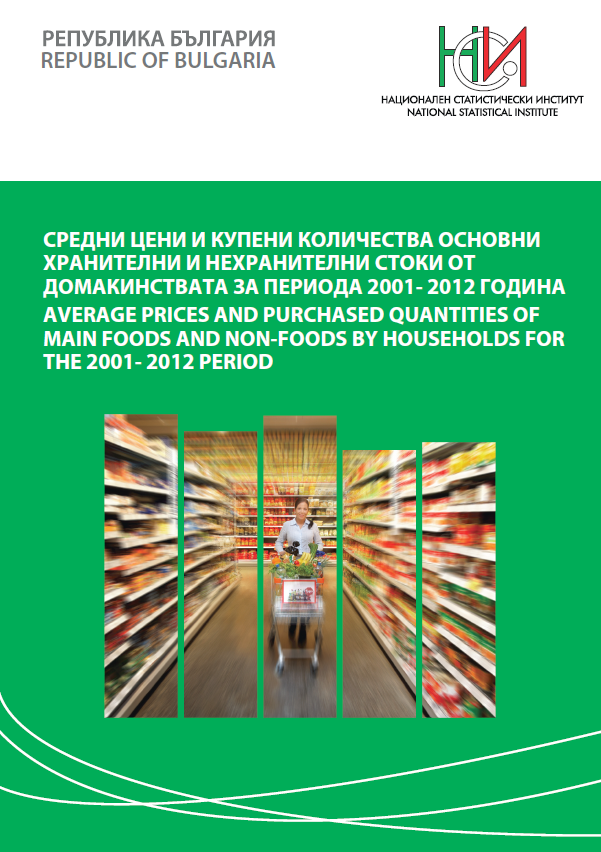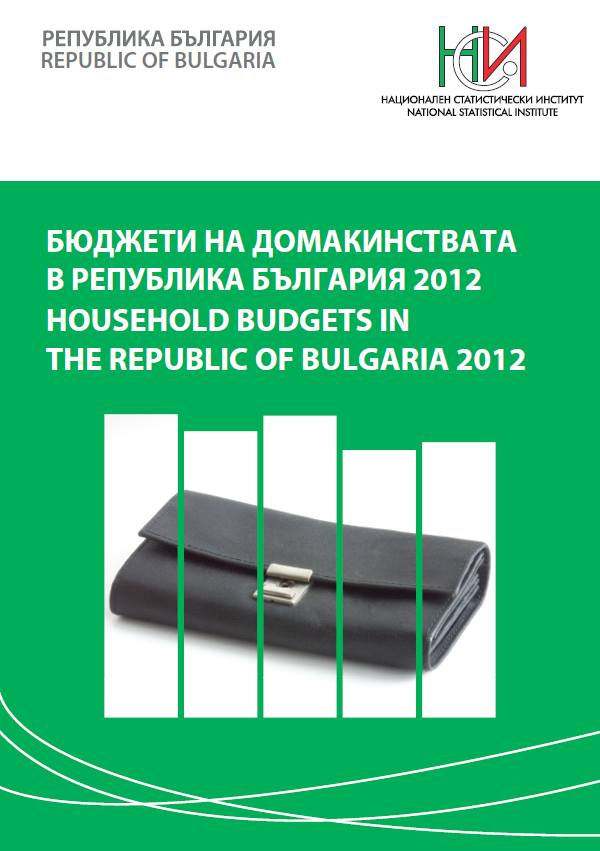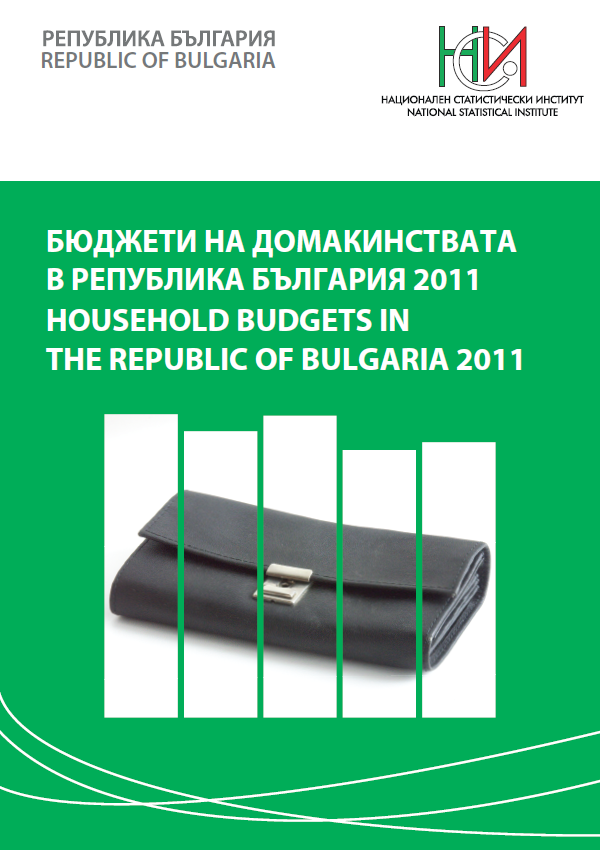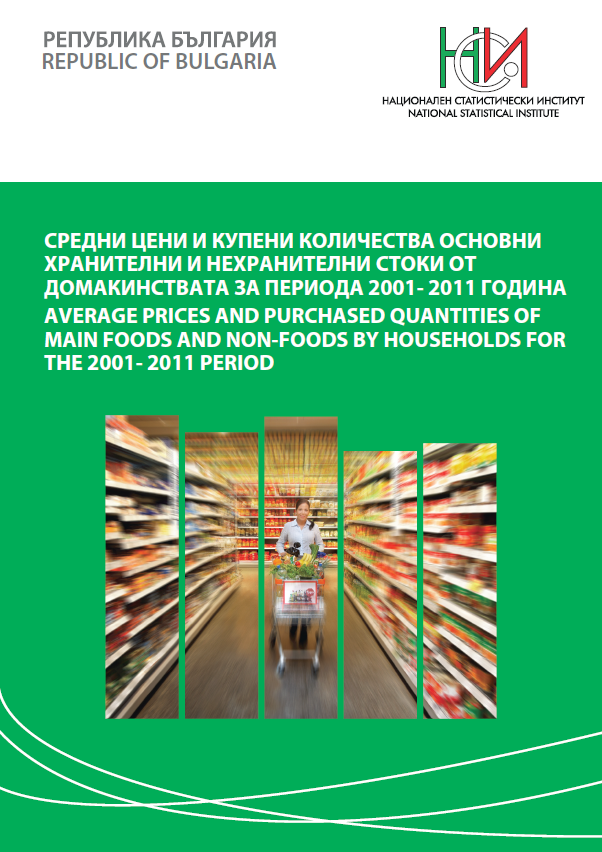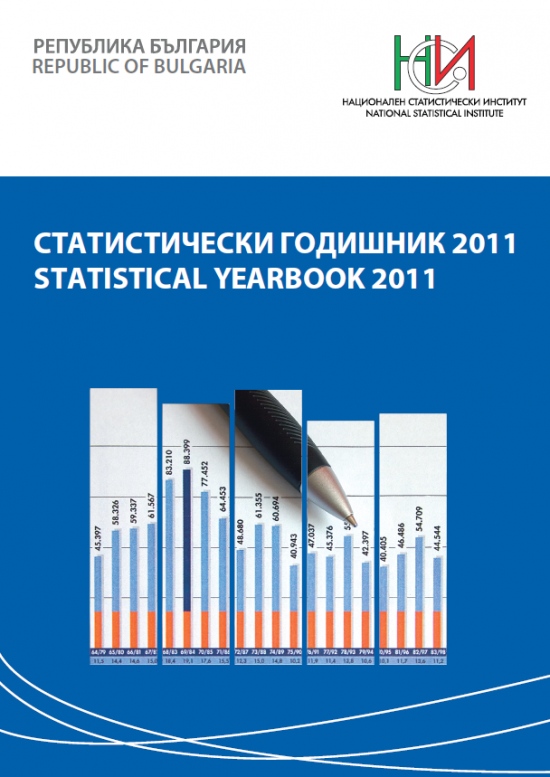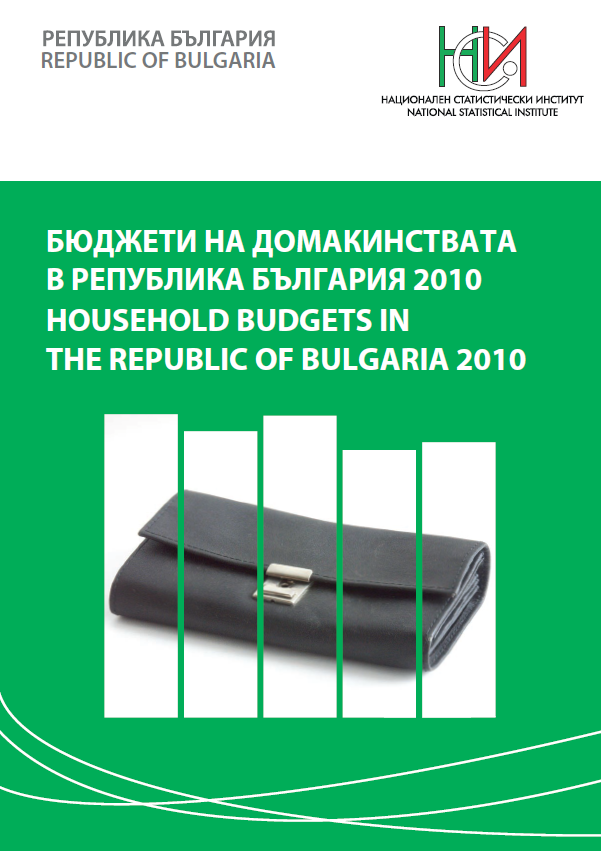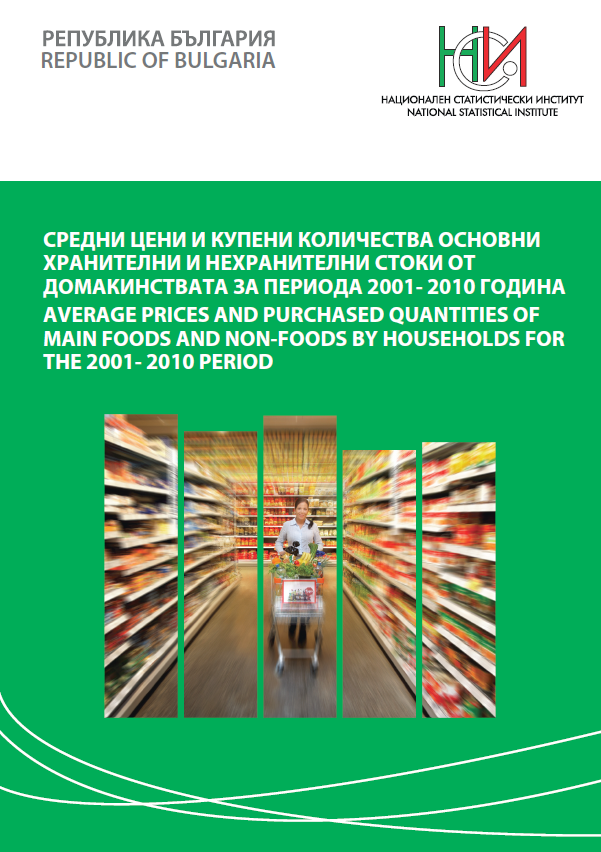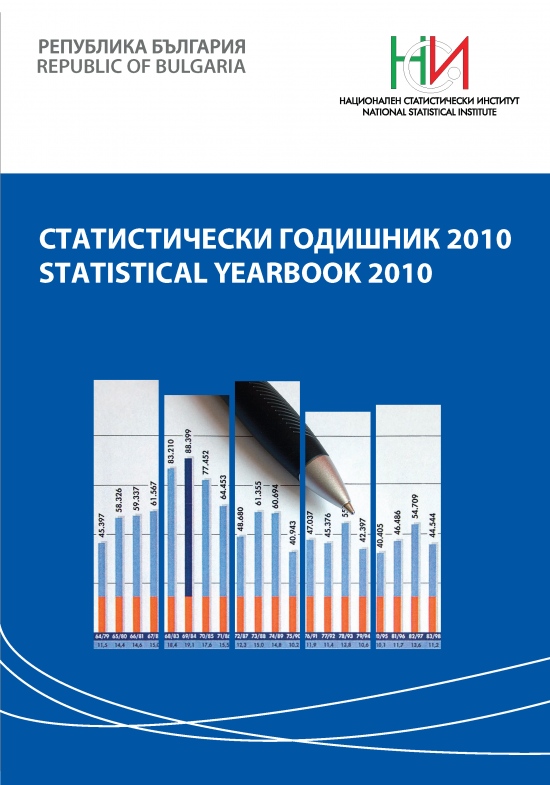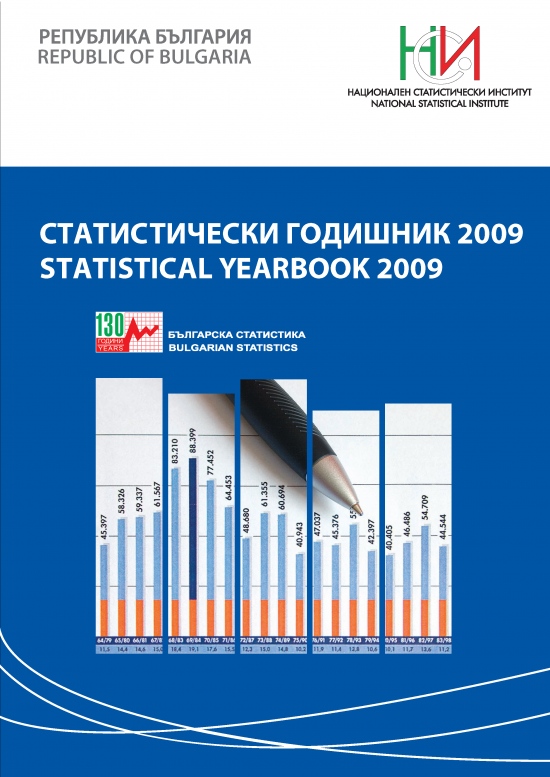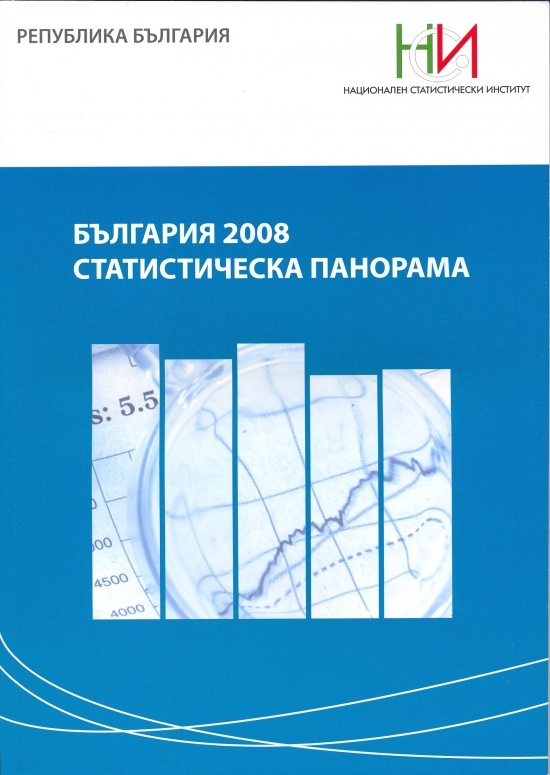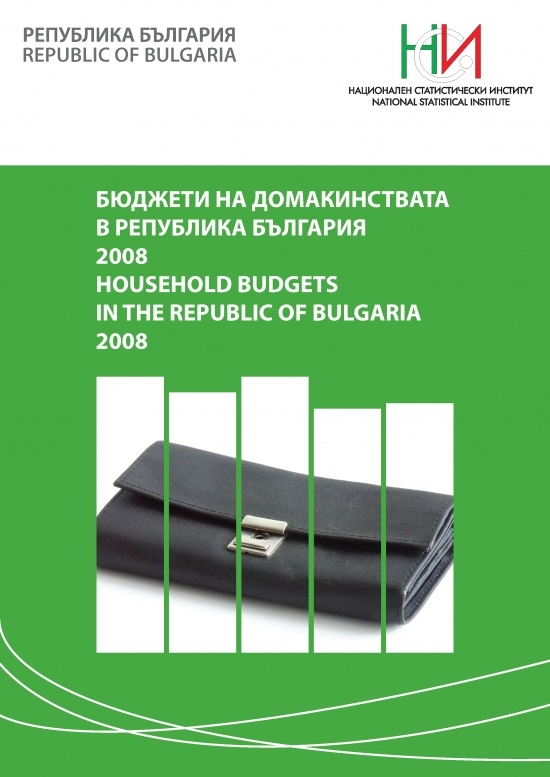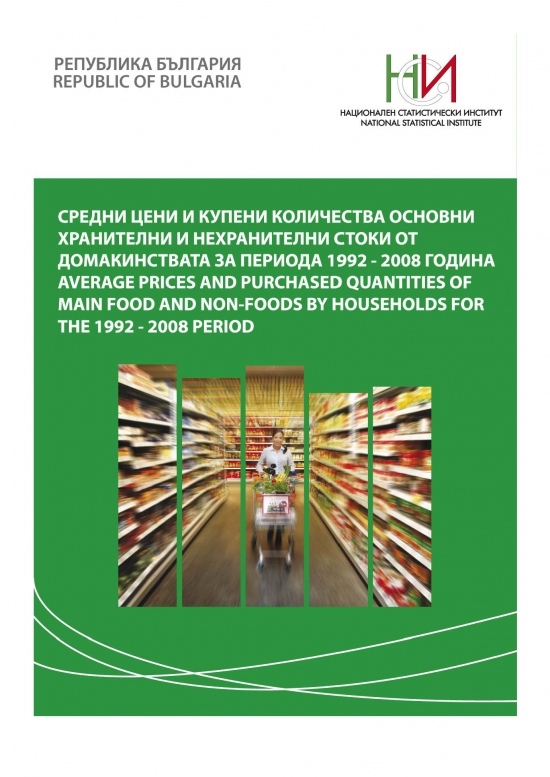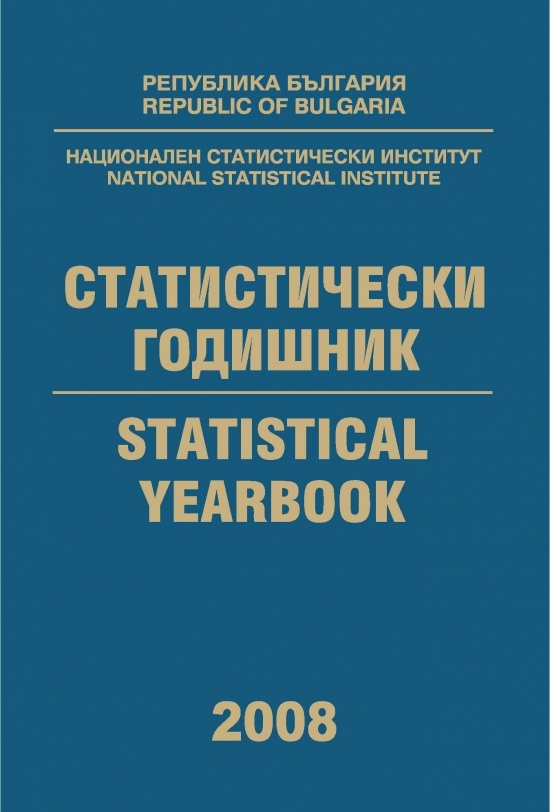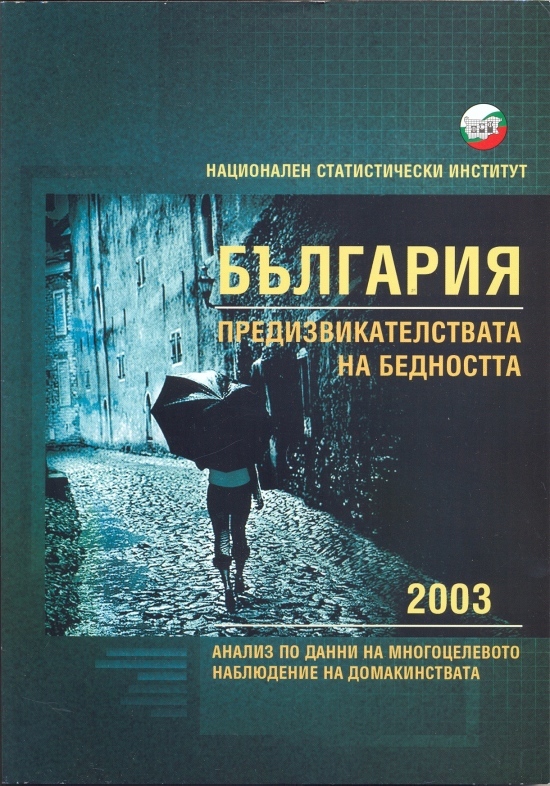Housing conditions of the households
| Share of the households with: | Total | Urban | Rural |
|---|---|---|---|
| Water supply system | 99.6 | 99.9 | 98.8 |
| Sewage | 84.6 | 97.5 | 43.3 |
| Electricity | 99.7 | 99.8 | 99.1 |
| Central heating system | 22.8 | 29.7 | 0.7 |
| Toilet indoor | 97.0 | 99.2 | 90.0 |
| Bath indoor | 98.1 | 98.9 | 95.5 |
| Contact | |
|---|---|
| Contact organisation | National Statistical Institute |
| Contact organisation unit | Statistics on Living Conditions Department |
| Contact name | Petia Manahova |
| Contact person function | State expert |
| Contact mail address | 2, P. Volov Str.; 1038 Sofia, Bulgaria |
| Contact email address | |
| Contact phone number | +359 2 9857 612 |
| Contact fax number | |
| Metadata update | |
| Metadata last certified | 24 April 2025 |
| Metadata last posted | 24 April 2025 |
| Metadata last update | 24 April 2025 |
| Statistical presentation | |
| Data description | The main objective of the household budget survey is to get reliable and scientifically founded data on the income, expenditure, consumption and other elements of the living standard of the population as well as changes which have occurred during the years. Household income includes all receipts of the household and its members during the surveyed period. The income is estimate in total and monetary form. Monetary income includes regular receipts from: wages and salaries, other earnings, entrepreneurship, property, pensions, social benefits, regular inter-household transfers, as well as sale of property and other irregular receipts. Total income includes monetary and valued income in kind. Household expenditure includes all resources spend by the household and its members during the surveyed period. The expenditures are estimated in total and monetary form. Monetary expenditure includes consumer expenditure on foods and non-alcoholic beverages; alcoholic beverages and tobacco; clothing and footwear; housing, water, electricity, gas and other fuels; furnishing and maintenance of the house; health; transport; communication; recreation, culture and education; miscellaneous goods and services; as well as taxes, social insurance, regular intro-household transfers and other non-consumer expenditure. Total expenditure includes monetary and valued expenditure in kind. Variables of household incomes and expenditures are estimated average per household and per person and as structure. Household consumption includes the quantities of main foods and beverages consumed at home. The catering data are not included. The variables are estimated by the household budget survey are calculated by balance method and are presented average per person. Housing conditions variables are: type of dwelling, number of rooms, availability of water supply system, sewerage, electricity, bath and toilet. Durables observed are: cars, TV sets, washing machines, refrigerators and freezers, telephones, computers, air-conditioners and others. |
| Classification system | · Classification on household income; · Classification of Individual Consumption by Purpose; · International Standard Classification of Education (ISCED 2011); · National Classification of Occupations and Duties-2011 (NCOD-2011); · Classification of Economic Activities (CEA-2008, for international use NACE.BG-2008); · Classification of territorial units for statistical purposes in Bulgaria (NUTS). |
| Sector coverage | The Household Budget Survey is a sample survey by implementation of two stage cluster. The general population from which the sample for the survey is formed comprises all the households in the country. Institutional households are not studied by the household budget survey. The unit of observation is every randomly chosen ordinary household irrespective of the number of members and their material and personal status. The sample size since 2010 is 3060 households each quarter. |
| Statistical concepts and definitions | Gross income Gross household income is aggregated value of all regular incomes of the household and its members during the surveyed period from wages and salaries, other earnings, entrepreneurship, property, pensions, social benefits and regular inter-household transfers. Net income Net household income is calculated from gross income after deduction of tax and contribution to social insurance. Consumer expenditure The consumer expenditure of a household includes the expenditure done by the household for satisfaction of the necessities of the household as a whole or some household members. Household A private household consists of two or more persons living in a dwelling or part of dwelling and sharing common budget, having their meals together, no matter relatives or not. One person living in a dwelling, separate room or part of room on his/her own budget also is considered a household. |
| Statistical unit | Household (ordinary household). |
| Statistical population | The general population from which the sample is formed comprises all ordinary households in the country. Institutional households are not studied by the HBS. |
| Reference area | According to the Classification of territorial units for statistical purposes in Bulgaria (NUTS). |
| Time coverage | Up to 2009 (monthly and yearly data), since 2010 - quarterly and yearly data. |
| Base period | Not applicable. |
| Unit of measure | |
BGN, per cent (%), kg, litre, number, number of persons. | |
| Reference period | |
Month (before 2009); Quarter (since 2010); Year | |
| Institutional mandate | |
| Legal acts and other agreements | Gentlemen agreement with Eurostat. |
| Data sharing | Not applicable. |
| Confidentiality | |
| Confidentiality - policy | · Law on Statistics; · Regulation (EC) No 223/2009 on European statistics; · Regulation (EU) 2016/679 on the protection of natural persons with regard to the processing of personal data and on the free movement of such data; · Law on personal data protection. |
| Confidentiality - data treatment | Individual data are not published in accordance with article 25 of the Law on Statistics. The publishing of individual data can be performed only in accordance with article 26 of the same law and Rules for provision of anonymised individual data for scientific and research purposes. |
| Release policy | |
| Release calendar | Dates for release are defined in the Release Calendar presenting the results of the statistical surveys carried out by the National Statistical Institute. Quarterly data on household income, expenditure and consumption is available 45 days after the reference period and annual data - in April of the year following the reference year. |
| Release calendar access | The calendar is available on the NSI website: https://www.nsi.bg/en/node/480 |
| User access | Data is published on the NSI website, section Households Income, Expenditure and Consumption and in the INFOSTAT Information system in accordance with the Law on Statistics and the European Statistics Code of Practice respecting the professional independence and aimed at objectivity, transparency and equal treatment of all consumers. |
| Frequency of dissemination | |
Monthly (to 2009), Quarterly (since 2010), Annual | |
| Accessibility and clarity | |
| News release | Household income, expenditure and consumption - quarterly and yearly. |
| Publications | · Publication "Household Budgets in the Republic of Bulgaria" - detailed annual data for different household groups (by place of residence, by number of household members, by number of employed persons, by number of children under 18, by total annual income per person in the household, by presence of pensioners, by professional and economic status of the household head, by decile groups); · Publication "Average prices and purchased quantities of main foods and non-foods by households" - contains data on the average prices and purchased quantities foods and non-foods by households by years and by quarters. The information from the survey of household budgets is used and because of that these average prices differ from the consumer prices published by the NSI. The purchased quantities foods are computed average per household and the purchased non-foods - average per 100 households. Published are also data on the purchasing power of households calculated by means of total and monetary income, as well as the changes in the purchasing power. · Booklet "Household Budget Survey"; · General Publications of the NSI. |
| On-line database | Detailed results on Household Budgets are available to all users of the NSI website under the heading Households Income, Expenditure and Consumption: https://www.nsi.bg/en/node/5640 and in the INFOSTAT Information system: https://infostat.nsi.bg/infostat/pages/module.jsf?x_2=27. |
| Micro-data access | Anonymised individual data can be provide for scientific and research purposes, and for individual request according to the Rules for the provision of anonymised individual data for scientific and research purposes. |
| Other | Information service on request, according to the Rules for the dissemination of statistical products and services in NSI. |
| Documentation on methodology | · Methodology and organisation of the household budgets survey: https://www.nsi.bg/sites/default/files/files/metadata/HH_HBS_Metodology_en.pdf · Instruction for interviewers of Household budget survey. |
| Quality documentation | Eurostat's quality reports of the Household Budget Survey in EU countries, 2005, 2010, 2015 and 2019. |
| Quality management | |
| Quality assurance | Through checking on field work and control of the thoroughness of the records in the diaries. |
| Quality assessment | Data are accompanied with quality reports analyzing the accuracy, coherence and comparability of the data. |
| Relevance | |
| User needs | The data is of interest to a wide number of users - state authorities, public and international organizations (Eurostat, UN, UNICEF, ILO, etc), students and others. |
| User satisfaction | Consultations with users:
|
| Completeness | Not applicable. |
| Accuracy and reliability | |
| Overall accuracy | As with any other sample survey, HBS may be burdened with errors due to sampling and other relating to the inability to be interviewed some of the units in the sample, as well as the errors taking place at the stage of data recording, data processing, etc. |
| Sampling error | The sampling errors calculated for main variables are published in annual publication "Household Budgets in the Republic of Bulgaria". |
| Non-sampling error | Like any statistical survey and household budget survey may contain non-sampling errors that arise at different stages of the study and which cannot be completely eliminated. Such errors are basically: · coverage errors · measurement errors that occur at the time of data collection · processing errors · non-response errors
In order to reduce non-sampling errors:
· update of the household lists for each of the first stage selection census enumeration areas;
· development of a clear research methodology, ongoing updating of data coding systems;
· using interviewers with experience in collecting, controlling, encoding and inputting data;
· conducting regular training seminars for the interviewers;
· assistance to the interviewers of the survey team at NSI;
· data control at the collection, input, and processing stage.
|
| Timeliness and punctuality | |
| Timeliness | Quarterly data are published 45 days after the reference period. Annual data are published in April of the year following the reference year. |
| Punctuality | The deadlines are observed: for quarterly data - 45 days after the reporting period, and for the annual ones - four months after the accounting year. |
| Coherence and comparability | |
| Comparability - geographical | Not applicable. |
| Comparability - over time | Long time series. |
| Coherence - cross domain |
Household budget survey is consistent with Consumer Price Index, Purchasing Power Parity and National Accounts. Additional analyzes are carried out to ensure consistency with the survey on income and living conditions.
|
| Coherence - internal | |
| Cost and burden | |
Every household takes part in the survey once a quarter. | |
| Data revision | |
| Data revision - policy | Not applicable. |
| Data revision - practice | Not applicable. |
| Statistical processing | |
| Source data | The general population from which the sample for the survey is formed comprises all the ordinary households in the country. When forming the sample a two stage cluster’s sampling on a territorial principle is implemented as follows:
Up to 2009 the selection of territorial units is done with a probability proportional to their size. Since 2010 non-proportional selection has applied in order to produce more accurate sample data in the small regions where the minimum quarter size of the sample include no less 72 households at the expense of decrease of the number of households in the large regions - Sofia (stolitsa), Plovdiv and Varna. In the selected enumeration areas (clusters) lists of the household are prepared and they are arranged into ascending order, depending on the number of persons. This indicator has a close correlation with the surveyed indicators - income, expenditure, and consumption per capita. 6 households from these lists are chosen from each cluster with a selection step. Since 2010 the sample size has been 3 060 households divided in three sub-samples each containing 1 020 households. Each sub-sample is surveyed one month per quarter by application of the method of rotation sample. The household budget survey applies the principle of the voluntary participation of households which had randomly come into the sample. Every randomly selected household which is not willing or is not able to cooperate is replaced with another from the same cluster and with the same number of members. Main documents of the Household budget survey are:
|
| Frequency of data collection | Monthly (to 2009), quarterly (since 2010) |
| Data collection | Data collection methods · method of writing down the data by one of the members of the observed household · method of the interview between the interviewer and the members of the household. The surveyed households keep a regular record in the Household Diary on: · total daily monetary expenditure per month for food products, non-food products, services and others; · all monetary incomes from working salary, social insurance, home production and others; · supply in kind and use of food products and non-food goods; · manufactured raw materials and products obtained from the processing; · number of people who had meals.
Since 2010 the households have kept retrospective records on: · irregular expenditure on non-foods during the previous two months; · some irregular income during the previous two months.
By interview data are collected on: · social demographic characteristics of the household and its members · availability of facilities and durables at the dwelling · availability of food products at the beginning of the month of observation and residues at the end of the month · the presence of farm animals in the household. The interviewers visit the household several times a month. During these visits they have a detailed conversation with the members of the household, check the completeness and reliability of the data entered into the diary. |
| Data validation |
In the process of entering information, logical control of the received information is performed.
|
| Data compilation |
Data processing is done with specially developed software for the research.
The information from the household budget survey is processed monthly at the Statistical Survey Departments of NSI regional offices and NSI and is summarized quarterly and annually in the NSI. Monthly control tables, quarterly, and annual estimates are obtained.
Monthly processing includes: • input and control of collected data for each household observed during the month; • summarizing the data for the individual household from the different input documents and forming an individual household budget; • data control for the individual household budgets; • applying methodologies for calculating additional result variables:
• obtaining tables with control monthly assessments of the main indicators for the survey;
Quarterly processing includes: • aggregation of monthly data; • applying methodologies for assessing individual household data for the two months during which they were not directly observed; • obtaining tables with quarterly estimates of the main indicators for the survey.
Annual processing includes: • aggregation of quarterly data; • applying methodologies to add retrospective data for the months when households are not directly observed; • obtaining tables with final quarterly estimates of the main indicators for the survey; • obtaining tables with annual estimates of the main indicators for the survey. |
| Adjustment | Not applicable. |
| Comment | |
ESS Standard for Quality Reports Structure (ESQRS)
| Contact | ||||||||||||||||||||||||||||||||||||||||||||||||||||||||||||||||||||||||||||||||||||||||||||||||||||||||||||||||||||||||||||||||||||||||||||||||||||||||||||||||||
|---|---|---|---|---|---|---|---|---|---|---|---|---|---|---|---|---|---|---|---|---|---|---|---|---|---|---|---|---|---|---|---|---|---|---|---|---|---|---|---|---|---|---|---|---|---|---|---|---|---|---|---|---|---|---|---|---|---|---|---|---|---|---|---|---|---|---|---|---|---|---|---|---|---|---|---|---|---|---|---|---|---|---|---|---|---|---|---|---|---|---|---|---|---|---|---|---|---|---|---|---|---|---|---|---|---|---|---|---|---|---|---|---|---|---|---|---|---|---|---|---|---|---|---|---|---|---|---|---|---|---|---|---|---|---|---|---|---|---|---|---|---|---|---|---|---|---|---|---|---|---|---|---|---|---|---|---|---|---|---|---|---|---|
| Contact organisation | National Statistical Institute | |||||||||||||||||||||||||||||||||||||||||||||||||||||||||||||||||||||||||||||||||||||||||||||||||||||||||||||||||||||||||||||||||||||||||||||||||||||||||||||||||
| Contact organisation unit | Statistics on Living Conditions Department | |||||||||||||||||||||||||||||||||||||||||||||||||||||||||||||||||||||||||||||||||||||||||||||||||||||||||||||||||||||||||||||||||||||||||||||||||||||||||||||||||
| Contact name | Petia Manahova | |||||||||||||||||||||||||||||||||||||||||||||||||||||||||||||||||||||||||||||||||||||||||||||||||||||||||||||||||||||||||||||||||||||||||||||||||||||||||||||||||
| Contact person function | State expert | |||||||||||||||||||||||||||||||||||||||||||||||||||||||||||||||||||||||||||||||||||||||||||||||||||||||||||||||||||||||||||||||||||||||||||||||||||||||||||||||||
| Contact mail address | 2, P. Volov Str.; 1038 Sofia, Bulgaria | |||||||||||||||||||||||||||||||||||||||||||||||||||||||||||||||||||||||||||||||||||||||||||||||||||||||||||||||||||||||||||||||||||||||||||||||||||||||||||||||||
| Contact email address | ||||||||||||||||||||||||||||||||||||||||||||||||||||||||||||||||||||||||||||||||||||||||||||||||||||||||||||||||||||||||||||||||||||||||||||||||||||||||||||||||||
| Contact phone number | +359 2 9857 612 | |||||||||||||||||||||||||||||||||||||||||||||||||||||||||||||||||||||||||||||||||||||||||||||||||||||||||||||||||||||||||||||||||||||||||||||||||||||||||||||||||
| Contact fax number | ||||||||||||||||||||||||||||||||||||||||||||||||||||||||||||||||||||||||||||||||||||||||||||||||||||||||||||||||||||||||||||||||||||||||||||||||||||||||||||||||||
| Statistical presentation | ||||||||||||||||||||||||||||||||||||||||||||||||||||||||||||||||||||||||||||||||||||||||||||||||||||||||||||||||||||||||||||||||||||||||||||||||||||||||||||||||||
| Data description | The main objective of the household budget survey is to get reliable and scientifically founded data on the income, expenditure, consumption and other elements of the living standard of the population as well as changes which have occurred during the years. Household income includes all receipts of the household and its members during the surveyed period. The income is estimate in total and monetary form. Monetary income includes regular receipts from: wages and salaries, other earnings, entrepreneurship, property, pensions, social benefits, regular inter-household transfers, as well as sale of property and other irregular receipts. Total income includes monetary and valued income in kind. Household expenditure includes all resources spend by the household and its members during the surveyed period. The expenditures are estimated in total and monetary form. Monetary expenditure includes consumer expenditure on foods and non-alcoholic beverages; alcoholic beverages and tobacco; clothing and footwear; housing, water, electricity, gas and other fuels; furnishing and maintenance of the house; health; transport; communication; recreation, culture and education; miscellaneous goods and services; as well as taxes, social insurance, regular intro-household transfers and other non-consumer expenditure. Total expenditure includes monetary and valued expenditure in kind. Variables of household incomes and expenditures are estimated average per household and per person and as structure. Household consumption includes the quantities of main foods and beverages consumed at home. The catering data are not included. The variables are estimated by the household budget survey are calculated by balance method and are presented average per person. Housing conditions variables are: type of dwelling, number of rooms, availability of water supply system, sewerage, electricity, bath and toilet. Durables observed are: cars, TV sets, washing machines, refrigerators and freezers, telephones, computers, air-conditioners and others. | |||||||||||||||||||||||||||||||||||||||||||||||||||||||||||||||||||||||||||||||||||||||||||||||||||||||||||||||||||||||||||||||||||||||||||||||||||||||||||||||||
| Classification system | · Classification on household income; · Classification of Individual Consumption by Purpose; · International Standard Classification of Education (ISCED 2011); · National Classification of Occupations and Duties-2011 (NCOD-2011); · Classification of Economic Activities (CEA-2008, for international use NACE.BG-2008); · Classification of territorial units for statistical purposes in Bulgaria (NUTS). | |||||||||||||||||||||||||||||||||||||||||||||||||||||||||||||||||||||||||||||||||||||||||||||||||||||||||||||||||||||||||||||||||||||||||||||||||||||||||||||||||
| Sector coverage | The Household Budget Survey is a sample survey by implementation of two stage cluster. The general population from which the sample for the survey is formed comprises all the households in the country. Institutional households are not studied by the household budget survey. The unit of observation is every randomly chosen ordinary household irrespective of the number of members and their material and personal status. The sample size since 2010 is 3060 households each quarter. | |||||||||||||||||||||||||||||||||||||||||||||||||||||||||||||||||||||||||||||||||||||||||||||||||||||||||||||||||||||||||||||||||||||||||||||||||||||||||||||||||
| Statistical concepts and definitions | Gross income Gross household income is aggregated value of all regular incomes of the household and its members during the surveyed period from wages and salaries, other earnings, entrepreneurship, property, pensions, social benefits and regular inter-household transfers. Net income Net household income is calculated from gross income after deduction of tax and contribution to social insurance. Consumer expenditure The consumer expenditure of a household includes the expenditure done by the household for satisfaction of the necessities of the household as a whole or some household members. Household A private household consists of two or more persons living in a dwelling or part of dwelling and sharing common budget, having their meals together, no matter relatives or not. One person living in a dwelling, separate room or part of room on his/her own budget also is considered a household. | |||||||||||||||||||||||||||||||||||||||||||||||||||||||||||||||||||||||||||||||||||||||||||||||||||||||||||||||||||||||||||||||||||||||||||||||||||||||||||||||||
| Statistical unit | Household (ordinary household). | |||||||||||||||||||||||||||||||||||||||||||||||||||||||||||||||||||||||||||||||||||||||||||||||||||||||||||||||||||||||||||||||||||||||||||||||||||||||||||||||||
| Statistical population | The general population from which the sample is formed comprises all ordinary households in the country. Institutional households are not studied by the HBS. | |||||||||||||||||||||||||||||||||||||||||||||||||||||||||||||||||||||||||||||||||||||||||||||||||||||||||||||||||||||||||||||||||||||||||||||||||||||||||||||||||
| Reference area | According to the Classification of territorial units for statistical purposes in Bulgaria (NUTS). | |||||||||||||||||||||||||||||||||||||||||||||||||||||||||||||||||||||||||||||||||||||||||||||||||||||||||||||||||||||||||||||||||||||||||||||||||||||||||||||||||
| Time coverage | Up to 2009 (monthly and yearly data), since 2010 - quarterly and yearly data. | |||||||||||||||||||||||||||||||||||||||||||||||||||||||||||||||||||||||||||||||||||||||||||||||||||||||||||||||||||||||||||||||||||||||||||||||||||||||||||||||||
| Base period | Not applicable. | |||||||||||||||||||||||||||||||||||||||||||||||||||||||||||||||||||||||||||||||||||||||||||||||||||||||||||||||||||||||||||||||||||||||||||||||||||||||||||||||||
| Statistical processing | ||||||||||||||||||||||||||||||||||||||||||||||||||||||||||||||||||||||||||||||||||||||||||||||||||||||||||||||||||||||||||||||||||||||||||||||||||||||||||||||||||
| Source data | The general population from which the sample for the survey is formed comprises all the ordinary households in the country. When forming the sample a two stage cluster’s sampling on a territorial principle is implemented as follows:
Up to 2009 the selection of territorial units is done with a probability proportional to their size. Since 2010 non-proportional selection has applied in order to produce more accurate sample data in the small regions where the minimum quarter size of the sample include no less 72 households at the expense of decrease of the number of households in the large regions - Sofia (stolitsa), Plovdiv and Varna. In the selected enumeration areas (clusters) lists of the household are prepared and they are arranged into ascending order, depending on the number of persons. This indicator has a close correlation with the surveyed indicators - income, expenditure, and consumption per capita. 6 households from these lists are chosen from each cluster with a selection step. Since 2010 the sample size has been 3 060 households divided in three sub-samples each containing 1 020 households. Each sub-sample is surveyed one month per quarter by application of the method of rotation sample. The household budget survey applies the principle of the voluntary participation of households which had randomly come into the sample. Every randomly selected household which is not willing or is not able to cooperate is replaced with another from the same cluster and with the same number of members. Main documents of the Household budget survey are:
| |||||||||||||||||||||||||||||||||||||||||||||||||||||||||||||||||||||||||||||||||||||||||||||||||||||||||||||||||||||||||||||||||||||||||||||||||||||||||||||||||
| Frequency of data collection | Monthly (to 2009), quarterly (since 2010) | |||||||||||||||||||||||||||||||||||||||||||||||||||||||||||||||||||||||||||||||||||||||||||||||||||||||||||||||||||||||||||||||||||||||||||||||||||||||||||||||||
| Data collection | Data collection methods · method of writing down the data by one of the members of the observed household · method of the interview between the interviewer and the members of the household. The surveyed households keep a regular record in the Household Diary on: · total daily monetary expenditure per month for food products, non-food products, services and others; · all monetary incomes from working salary, social insurance, home production and others; · supply in kind and use of food products and non-food goods; · manufactured raw materials and products obtained from the processing; · number of people who had meals.
Since 2010 the households have kept retrospective records on: · irregular expenditure on non-foods during the previous two months; · some irregular income during the previous two months.
By interview data are collected on: · social demographic characteristics of the household and its members · availability of facilities and durables at the dwelling · availability of food products at the beginning of the month of observation and residues at the end of the month · the presence of farm animals in the household. The interviewers visit the household several times a month. During these visits they have a detailed conversation with the members of the household, check the completeness and reliability of the data entered into the diary. | |||||||||||||||||||||||||||||||||||||||||||||||||||||||||||||||||||||||||||||||||||||||||||||||||||||||||||||||||||||||||||||||||||||||||||||||||||||||||||||||||
| Data validation |
In the process of entering information, logical control of the received information is performed.
| |||||||||||||||||||||||||||||||||||||||||||||||||||||||||||||||||||||||||||||||||||||||||||||||||||||||||||||||||||||||||||||||||||||||||||||||||||||||||||||||||
| Data compilation |
Data processing is done with specially developed software for the research.
The information from the household budget survey is processed monthly at the Statistical Survey Departments of NSI regional offices and NSI and is summarized quarterly and annually in the NSI. Monthly control tables, quarterly, and annual estimates are obtained.
Monthly processing includes: • input and control of collected data for each household observed during the month; • summarizing the data for the individual household from the different input documents and forming an individual household budget; • data control for the individual household budgets; • applying methodologies for calculating additional result variables:
• obtaining tables with control monthly assessments of the main indicators for the survey;
Quarterly processing includes: • aggregation of monthly data; • applying methodologies for assessing individual household data for the two months during which they were not directly observed; • obtaining tables with quarterly estimates of the main indicators for the survey.
Annual processing includes: • aggregation of quarterly data; • applying methodologies to add retrospective data for the months when households are not directly observed; • obtaining tables with final quarterly estimates of the main indicators for the survey; • obtaining tables with annual estimates of the main indicators for the survey. | |||||||||||||||||||||||||||||||||||||||||||||||||||||||||||||||||||||||||||||||||||||||||||||||||||||||||||||||||||||||||||||||||||||||||||||||||||||||||||||||||
| Adjustment | Not applicable. | |||||||||||||||||||||||||||||||||||||||||||||||||||||||||||||||||||||||||||||||||||||||||||||||||||||||||||||||||||||||||||||||||||||||||||||||||||||||||||||||||
| Quality management | ||||||||||||||||||||||||||||||||||||||||||||||||||||||||||||||||||||||||||||||||||||||||||||||||||||||||||||||||||||||||||||||||||||||||||||||||||||||||||||||||||
| Quality assurance | Through checking on field work and control of the thoroughness of the records in the diaries. | |||||||||||||||||||||||||||||||||||||||||||||||||||||||||||||||||||||||||||||||||||||||||||||||||||||||||||||||||||||||||||||||||||||||||||||||||||||||||||||||||
| Quality assessment | Data are accompanied with quality reports analyzing the accuracy, coherence and comparability of the data. | |||||||||||||||||||||||||||||||||||||||||||||||||||||||||||||||||||||||||||||||||||||||||||||||||||||||||||||||||||||||||||||||||||||||||||||||||||||||||||||||||
| Relevance | ||||||||||||||||||||||||||||||||||||||||||||||||||||||||||||||||||||||||||||||||||||||||||||||||||||||||||||||||||||||||||||||||||||||||||||||||||||||||||||||||||
| User needs | The data is of interest to a wide number of users - state authorities, public and international organizations (Eurostat, UN, UNICEF, ILO, etc), students and others. | |||||||||||||||||||||||||||||||||||||||||||||||||||||||||||||||||||||||||||||||||||||||||||||||||||||||||||||||||||||||||||||||||||||||||||||||||||||||||||||||||
| User satisfaction | Consultations with users:
| |||||||||||||||||||||||||||||||||||||||||||||||||||||||||||||||||||||||||||||||||||||||||||||||||||||||||||||||||||||||||||||||||||||||||||||||||||||||||||||||||
| Completeness | Not applicable. | |||||||||||||||||||||||||||||||||||||||||||||||||||||||||||||||||||||||||||||||||||||||||||||||||||||||||||||||||||||||||||||||||||||||||||||||||||||||||||||||||
| Data completeness - rate | Not applicable. | |||||||||||||||||||||||||||||||||||||||||||||||||||||||||||||||||||||||||||||||||||||||||||||||||||||||||||||||||||||||||||||||||||||||||||||||||||||||||||||||||
| Accuracy and reliability | ||||||||||||||||||||||||||||||||||||||||||||||||||||||||||||||||||||||||||||||||||||||||||||||||||||||||||||||||||||||||||||||||||||||||||||||||||||||||||||||||||
| Overall accuracy | As with any other sample survey, HBS may be burdened with errors due to sampling and other relating to the inability to be interviewed some of the units in the sample, as well as the errors taking place at the stage of data recording, data processing, etc. | |||||||||||||||||||||||||||||||||||||||||||||||||||||||||||||||||||||||||||||||||||||||||||||||||||||||||||||||||||||||||||||||||||||||||||||||||||||||||||||||||
| Sampling error | The sampling errors calculated for main variables are published in annual publication "Household Budgets in the Republic of Bulgaria". | |||||||||||||||||||||||||||||||||||||||||||||||||||||||||||||||||||||||||||||||||||||||||||||||||||||||||||||||||||||||||||||||||||||||||||||||||||||||||||||||||
| Sampling errors - indicators |
| |||||||||||||||||||||||||||||||||||||||||||||||||||||||||||||||||||||||||||||||||||||||||||||||||||||||||||||||||||||||||||||||||||||||||||||||||||||||||||||||||
| Non-sampling error | Like any statistical survey and household budget survey may contain non-sampling errors that arise at different stages of the study and which cannot be completely eliminated. Such errors are basically: · coverage errors · measurement errors that occur at the time of data collection · processing errors · non-response errors
In order to reduce non-sampling errors:
· update of the household lists for each of the first stage selection census enumeration areas;
· development of a clear research methodology, ongoing updating of data coding systems;
· using interviewers with experience in collecting, controlling, encoding and inputting data;
· conducting regular training seminars for the interviewers;
· assistance to the interviewers of the survey team at NSI;
· data control at the collection, input, and processing stage.
| |||||||||||||||||||||||||||||||||||||||||||||||||||||||||||||||||||||||||||||||||||||||||||||||||||||||||||||||||||||||||||||||||||||||||||||||||||||||||||||||||
| Coverage error | Some of the sampled households cannot be found at the address. In order to preserve the sample size, the principle of substitution applies to these households.
Replaced households not contacted in 2024
| |||||||||||||||||||||||||||||||||||||||||||||||||||||||||||||||||||||||||||||||||||||||||||||||||||||||||||||||||||||||||||||||||||||||||||||||||||||||||||||||||
| Over-coverage - rate | Not applicable. | |||||||||||||||||||||||||||||||||||||||||||||||||||||||||||||||||||||||||||||||||||||||||||||||||||||||||||||||||||||||||||||||||||||||||||||||||||||||||||||||||
| Common units - proportion | Not applicable. | |||||||||||||||||||||||||||||||||||||||||||||||||||||||||||||||||||||||||||||||||||||||||||||||||||||||||||||||||||||||||||||||||||||||||||||||||||||||||||||||||
| Measurement error | At the data collection stage, errors may also occur: · inaccurate or incomplete answers from respondents - to minimize these errors, interviewers check the correctness and completeness of the records by asking additional reminders; · improperly recorded data from the interviewers - a large number of arithmetic and logic controls have been introduced in the processing programs to limit this type of error. | |||||||||||||||||||||||||||||||||||||||||||||||||||||||||||||||||||||||||||||||||||||||||||||||||||||||||||||||||||||||||||||||||||||||||||||||||||||||||||||||||
| Non response error | Some of the households in the sample do not want or cannot participate in the survey for a variety of reasons: · skepticism in respect of the survey objectives · skepticism in respect of the official institutions · suspicion in preserving anonymity · insufficient remuneration for participation · lack of time · other reasons for refusal · poor health · lack of communication with the household because of misunderstanding and non-communication in Bulgarian · other reasons
To reduce the negative impact on estimates of non-response, the household budget survey uses the substitution principle.Every randomly selected household which is not willing or is not able to cooperate is replaced with another from the same cluster and with the same number of members. | |||||||||||||||||||||||||||||||||||||||||||||||||||||||||||||||||||||||||||||||||||||||||||||||||||||||||||||||||||||||||||||||||||||||||||||||||||||||||||||||||
| Unit non-response - rate |
| |||||||||||||||||||||||||||||||||||||||||||||||||||||||||||||||||||||||||||||||||||||||||||||||||||||||||||||||||||||||||||||||||||||||||||||||||||||||||||||||||
| Item non-response - rate | Not applicable. | |||||||||||||||||||||||||||||||||||||||||||||||||||||||||||||||||||||||||||||||||||||||||||||||||||||||||||||||||||||||||||||||||||||||||||||||||||||||||||||||||
| Processing error | In order to minimize possible errors, a large number of arithmetic and logical controls are included in the programs for input and processing of household budget survey data. For example: - For the items of the monetary expenses for which they are registered quantities and values, upon data entry automatically is calculated price and it is checked whether the price is within minimum and maximum price limits. - Ownership of the dwelling is tied to the payment or not of rent for a dwelling, and the availability of central heating - respectively the paid bills for heating. - A logical link is established between the registered economic activity of the person and the corresponding type of income received by him as salary, pension, compensation etc. - Completed or ongoing education is tied to the age of the person. - The presence of farm animals of a given species is associated with the products derived therefrom such as milk, eggs, meat, honey, wool. All arithmetic and logical controls are detailed in the study's terms of reference. | |||||||||||||||||||||||||||||||||||||||||||||||||||||||||||||||||||||||||||||||||||||||||||||||||||||||||||||||||||||||||||||||||||||||||||||||||||||||||||||||||
| Imputation - rate | Not applicable. | |||||||||||||||||||||||||||||||||||||||||||||||||||||||||||||||||||||||||||||||||||||||||||||||||||||||||||||||||||||||||||||||||||||||||||||||||||||||||||||||||
| Model assumption error | Not applicable. | |||||||||||||||||||||||||||||||||||||||||||||||||||||||||||||||||||||||||||||||||||||||||||||||||||||||||||||||||||||||||||||||||||||||||||||||||||||||||||||||||
| Seasonal adjustment | Not applicable. | |||||||||||||||||||||||||||||||||||||||||||||||||||||||||||||||||||||||||||||||||||||||||||||||||||||||||||||||||||||||||||||||||||||||||||||||||||||||||||||||||
| Data revision - policy | Not applicable. | |||||||||||||||||||||||||||||||||||||||||||||||||||||||||||||||||||||||||||||||||||||||||||||||||||||||||||||||||||||||||||||||||||||||||||||||||||||||||||||||||
| Data revision - practice | Not applicable. | |||||||||||||||||||||||||||||||||||||||||||||||||||||||||||||||||||||||||||||||||||||||||||||||||||||||||||||||||||||||||||||||||||||||||||||||||||||||||||||||||
| Data revision - average size | Not applicable. | |||||||||||||||||||||||||||||||||||||||||||||||||||||||||||||||||||||||||||||||||||||||||||||||||||||||||||||||||||||||||||||||||||||||||||||||||||||||||||||||||
| Timeliness and punctuality | ||||||||||||||||||||||||||||||||||||||||||||||||||||||||||||||||||||||||||||||||||||||||||||||||||||||||||||||||||||||||||||||||||||||||||||||||||||||||||||||||||
| Timeliness | Quarterly data are published 45 days after the reference period. Annual data are published in April of the year following the reference year. | |||||||||||||||||||||||||||||||||||||||||||||||||||||||||||||||||||||||||||||||||||||||||||||||||||||||||||||||||||||||||||||||||||||||||||||||||||||||||||||||||
| Time lag - first results | First annual results are available 4 months after the end of the surveyed year. | |||||||||||||||||||||||||||||||||||||||||||||||||||||||||||||||||||||||||||||||||||||||||||||||||||||||||||||||||||||||||||||||||||||||||||||||||||||||||||||||||
| Time lag - final results | Final results are available 12 months after the end of the surveyed year. | |||||||||||||||||||||||||||||||||||||||||||||||||||||||||||||||||||||||||||||||||||||||||||||||||||||||||||||||||||||||||||||||||||||||||||||||||||||||||||||||||
| Punctuality | The deadlines are observed: for quarterly data - 45 days after the reporting period, and for the annual ones - four months after the accounting year. | |||||||||||||||||||||||||||||||||||||||||||||||||||||||||||||||||||||||||||||||||||||||||||||||||||||||||||||||||||||||||||||||||||||||||||||||||||||||||||||||||
| Punctuality - delivery and publication | Not applicable. | |||||||||||||||||||||||||||||||||||||||||||||||||||||||||||||||||||||||||||||||||||||||||||||||||||||||||||||||||||||||||||||||||||||||||||||||||||||||||||||||||
| Coherence and comparability | ||||||||||||||||||||||||||||||||||||||||||||||||||||||||||||||||||||||||||||||||||||||||||||||||||||||||||||||||||||||||||||||||||||||||||||||||||||||||||||||||||
| Comparability - geographical | Not applicable. | |||||||||||||||||||||||||||||||||||||||||||||||||||||||||||||||||||||||||||||||||||||||||||||||||||||||||||||||||||||||||||||||||||||||||||||||||||||||||||||||||
| Asymmetry for mirror flows statistics - coefficient | Not applicable. | |||||||||||||||||||||||||||||||||||||||||||||||||||||||||||||||||||||||||||||||||||||||||||||||||||||||||||||||||||||||||||||||||||||||||||||||||||||||||||||||||
| Comparability - over time | Long time series. | |||||||||||||||||||||||||||||||||||||||||||||||||||||||||||||||||||||||||||||||||||||||||||||||||||||||||||||||||||||||||||||||||||||||||||||||||||||||||||||||||
| Length of comparable time series | Not required. | |||||||||||||||||||||||||||||||||||||||||||||||||||||||||||||||||||||||||||||||||||||||||||||||||||||||||||||||||||||||||||||||||||||||||||||||||||||||||||||||||
| Coherence - cross domain |
Household budget survey is consistent with Consumer Price Index, Purchasing Power Parity and National Accounts. Additional analyzes are carried out to ensure consistency with the survey on income and living conditions.
| |||||||||||||||||||||||||||||||||||||||||||||||||||||||||||||||||||||||||||||||||||||||||||||||||||||||||||||||||||||||||||||||||||||||||||||||||||||||||||||||||
| Coherence - sub annual and annual statistics |
| |||||||||||||||||||||||||||||||||||||||||||||||||||||||||||||||||||||||||||||||||||||||||||||||||||||||||||||||||||||||||||||||||||||||||||||||||||||||||||||||||
| Coherence - National Accounts | The structure of consumer expenditures from household budget survey for the 12 major COICOP classification groups is compared with a similar structure, calculated from a National Accounts database. | |||||||||||||||||||||||||||||||||||||||||||||||||||||||||||||||||||||||||||||||||||||||||||||||||||||||||||||||||||||||||||||||||||||||||||||||||||||||||||||||||
| Coherence - internal | ||||||||||||||||||||||||||||||||||||||||||||||||||||||||||||||||||||||||||||||||||||||||||||||||||||||||||||||||||||||||||||||||||||||||||||||||||||||||||||||||||
| Accessibility and clarity | ||||||||||||||||||||||||||||||||||||||||||||||||||||||||||||||||||||||||||||||||||||||||||||||||||||||||||||||||||||||||||||||||||||||||||||||||||||||||||||||||||
| News release | Household income, expenditure and consumption - quarterly and yearly. | |||||||||||||||||||||||||||||||||||||||||||||||||||||||||||||||||||||||||||||||||||||||||||||||||||||||||||||||||||||||||||||||||||||||||||||||||||||||||||||||||
| Publications | · Publication "Household Budgets in the Republic of Bulgaria" - detailed annual data for different household groups (by place of residence, by number of household members, by number of employed persons, by number of children under 18, by total annual income per person in the household, by presence of pensioners, by professional and economic status of the household head, by decile groups); · Publication "Average prices and purchased quantities of main foods and non-foods by households" - contains data on the average prices and purchased quantities foods and non-foods by households by years and by quarters. The information from the survey of household budgets is used and because of that these average prices differ from the consumer prices published by the NSI. The purchased quantities foods are computed average per household and the purchased non-foods - average per 100 households. Published are also data on the purchasing power of households calculated by means of total and monetary income, as well as the changes in the purchasing power. · Booklet "Household Budget Survey"; · General Publications of the NSI. | |||||||||||||||||||||||||||||||||||||||||||||||||||||||||||||||||||||||||||||||||||||||||||||||||||||||||||||||||||||||||||||||||||||||||||||||||||||||||||||||||
| On-line database | Detailed results on Household Budgets are available to all users of the NSI website under the heading Households Income, Expenditure and Consumption: https://www.nsi.bg/en/node/5640 and in the INFOSTAT Information system: https://infostat.nsi.bg/infostat/pages/module.jsf?x_2=27. | |||||||||||||||||||||||||||||||||||||||||||||||||||||||||||||||||||||||||||||||||||||||||||||||||||||||||||||||||||||||||||||||||||||||||||||||||||||||||||||||||
| Data tables - consultations | ||||||||||||||||||||||||||||||||||||||||||||||||||||||||||||||||||||||||||||||||||||||||||||||||||||||||||||||||||||||||||||||||||||||||||||||||||||||||||||||||||
| Micro-data access | Anonymised individual data can be provide for scientific and research purposes, and for individual request according to the Rules for the provision of anonymised individual data for scientific and research purposes. | |||||||||||||||||||||||||||||||||||||||||||||||||||||||||||||||||||||||||||||||||||||||||||||||||||||||||||||||||||||||||||||||||||||||||||||||||||||||||||||||||
| Other | Information service on request, according to the Rules for the dissemination of statistical products and services in NSI. | |||||||||||||||||||||||||||||||||||||||||||||||||||||||||||||||||||||||||||||||||||||||||||||||||||||||||||||||||||||||||||||||||||||||||||||||||||||||||||||||||
| Metadata - consultations | ||||||||||||||||||||||||||||||||||||||||||||||||||||||||||||||||||||||||||||||||||||||||||||||||||||||||||||||||||||||||||||||||||||||||||||||||||||||||||||||||||
| Documentation on methodology | · Methodology and organisation of the household budgets survey: https://www.nsi.bg/sites/default/files/files/metadata/HH_HBS_Metodology_en.pdf · Instruction for interviewers of Household budget survey. | |||||||||||||||||||||||||||||||||||||||||||||||||||||||||||||||||||||||||||||||||||||||||||||||||||||||||||||||||||||||||||||||||||||||||||||||||||||||||||||||||
| Metadata completeness – rate | ||||||||||||||||||||||||||||||||||||||||||||||||||||||||||||||||||||||||||||||||||||||||||||||||||||||||||||||||||||||||||||||||||||||||||||||||||||||||||||||||||
| Quality documentation | Eurostat's quality reports of the Household Budget Survey in EU countries, 2005, 2010, 2015 and 2019. | |||||||||||||||||||||||||||||||||||||||||||||||||||||||||||||||||||||||||||||||||||||||||||||||||||||||||||||||||||||||||||||||||||||||||||||||||||||||||||||||||
| Cost and burden | ||||||||||||||||||||||||||||||||||||||||||||||||||||||||||||||||||||||||||||||||||||||||||||||||||||||||||||||||||||||||||||||||||||||||||||||||||||||||||||||||||
Every household takes part in the survey once a quarter. | ||||||||||||||||||||||||||||||||||||||||||||||||||||||||||||||||||||||||||||||||||||||||||||||||||||||||||||||||||||||||||||||||||||||||||||||||||||||||||||||||||
| Confidentiality | ||||||||||||||||||||||||||||||||||||||||||||||||||||||||||||||||||||||||||||||||||||||||||||||||||||||||||||||||||||||||||||||||||||||||||||||||||||||||||||||||||
| Confidentiality - policy | · Law on Statistics; · Regulation (EC) No 223/2009 on European statistics; · Regulation (EU) 2016/679 on the protection of natural persons with regard to the processing of personal data and on the free movement of such data; · Law on personal data protection. | |||||||||||||||||||||||||||||||||||||||||||||||||||||||||||||||||||||||||||||||||||||||||||||||||||||||||||||||||||||||||||||||||||||||||||||||||||||||||||||||||
| Confidentiality – data treatment | Individual data are not published in accordance with article 25 of the Law on Statistics. The publishing of individual data can be performed only in accordance with article 26 of the same law and Rules for provision of anonymised individual data for scientific and research purposes. | |||||||||||||||||||||||||||||||||||||||||||||||||||||||||||||||||||||||||||||||||||||||||||||||||||||||||||||||||||||||||||||||||||||||||||||||||||||||||||||||||
| Comment | ||||||||||||||||||||||||||||||||||||||||||||||||||||||||||||||||||||||||||||||||||||||||||||||||||||||||||||||||||||||||||||||||||||||||||||||||||||||||||||||||||
Income, Expenditure and Consumption of Households in 2024
According to data from the Household Budget Survey, the annual total income average per capita was 12 857 BGN in 2024, there was an increase of 18.5% compared to 2023.
Bulgarian households spent an average of 11 712 BGN per capita in 2023, or 16.6% more compared to 2023.
In 2024, there were changes in the consumption of basic food products on average per person compared to 2023. The consumption of bread and paste products and of potatoes decreased. The biggest increase was in the consumption of soft drinks, fruit, and meat.
...Household Income, Expenditure and Consumption during the Fourth Quarter of 2024
According to data from the Household Budget Survey, during the fourth quarter of 2024 the quarterly total income average per household member was 3 371 BGN and it increased by 17.6% compared to the same quarter of 2023.
The quarterly total expenditure average per household member during the fourth quarter of 2024 was 3 033 BGN and increased by 13.7% compared to the same quarter of 2023.
In the fourth quarter of 2024, there were changes in the consumption of basic food products on average per person compared to the same quarter ...
Household Income, Expenditure and Consumption during the Third Quarter of 2024
According to data from the Household Budget Survey, during the third quarter of 2024 the quarterly total income average per household member was 3 351 BGN and it increased by 16.6% compared to the same quarter of 2023.
The quarterly total expenditure average per household member during the third quarter of 2024 was 3 153 BGN and increased by 16.2% compared to the same quarter of 2023.
In the third quarter of 2024, there were changes in the consumption of basic food products on average per person compared to the...
Household Income, Expenditure and Consumption during the Second Quarter of 2024
According to data from the Household Budget Survey, during the second quarter of 2024 the quarterly total income average per household member was 3 216 BGN and it increased by 20.5% compared to the same quarter of 2023.
The quarterly total expenditure average per household member during the second quarter of 2024 was 2 826 BGN and increased by 18.8% compared to the same quarter of 2023.
In the second quarter of 2024, there were changes in the consumption of basic food products on average per person compared to ...
Household Income, Expenditure and Consumption during the First Quarter of 2024
According to data from the Household Budget Survey, the quarterly total income average per household member during the first quarter of 2024 was 2 840 BGN and increased by 18.6% compared to the same quarter of 2023.
The quarterly total expenditure average per household member during the first quarter of 2024 was 2 524 BGN and increased by 17.4% compared to the same quarter of 2023.
In the first quarter of 2024, there were changes in the consumption of basic food products on average per person compared to the same quarter of 2023. The biggest increase was in the...
Income, Expenditure and Consumption of Households in 2023
According to data from the Household Budget Survey, the annual total income average per capita is 10 846 BGN in 2023, an increase of 20.4% compared to 2022.
Bulgarian households spent an average of 10 044 BGN per capita in 2023, or 19.7% more compared to 2022.
In 2023, there were changes in the consumption of basic food products on average per person compared to 2022. The biggest decrease was in the consumption of bread and paste products and yoghurt. The consumption of meat products, of fruit, of non-alcoholic beverages, and of alcoholic beverages increased.
T...
Household Income, Expenditure and Consumption during the Fourth Quarter of 2023
According to data from the Household Budget Survey, the quarterly total income average per household member during the fourth quarter of 2023 is 2 866 BGN and increases by 18.1% compared to the same quarter of 2022.
The quarterly total expenditure average per household member during the fourth quarter of 2023 is 2 668 BGN and increases by 18.1% compared to the same quarter of 2022.
The consumption of most basic food products on average per household member during the fourth quarter of 2023 changes compared to t...
Additional questionnaire under the Household Budget Survey in the Third Quarter of 2023
According to data from the additional questionnaire under the Household Budget Survey in the third quarter of 2023, the income of 31.7% of households increased compared to the previous 12 months. The share of individuals who have difficulty covering their daily expenses is 70.1%, which is almost the same compared to the previous quarter.
The survey is conducted under the project ‘Income and Living Conditions (ILC) - Statistical infrastructure under IESS - SILC 2024, 6-year module ‘Access to services’ - Pilot collection of annual data for 2023’ under Grant Agreement with the Europe...
Household Income, Expenditure and Consumption during the Third Quarter of 2023
According to data from the Household Budget Survey, the quarterly total income average per household member during the third quarter of 2023 is 2 874 BGN and increases by 22.5% compared to the same quarter of 2022.
The quarterly total expenditure average per household member during the third quarter of 2023 is 2 714 BGN and increases by 21.2% compared to the same quarter of 2022.
The consumption of most basic food products on average per household member during the third quarter of 2023 decreased compared to the sam...
Additional questionnaire under the Household Budget Survey in the Second Quarter of 2023
According to data from the additional questionnaire under the Household Budget Survey in the second quarter of 2023, the income of 78.0% of households remained unchanged compared to the previous 12 months. 70.6% of respondents have difficulties in covering daily expenses, but they decreased by 6.2 percentage points compared to the previous quarter. Nearly 1/4 of people limit their energy consumption.
The survey is conducted under the project ‘Income and Living Conditions (ILC) - Statistical infrastructure under IESS - SILC 2024, 6-year module ‘Access to services’ - ...
Household Income, Expenditure and Consumption during the Second Quarter of 2023
According to data from the Household Budget Survey in the second quarter of 2023, the quarterly total income average per household member during the second quarter of 2023 is 2 668 BGN and increases by 20.9% compared to the same quarter of 2022.
The quarterly total expenditure average per household member during the second quarter of 2023 is 2 379 BGN and increases by 21.3% compared to the same quarter of 2022.
The consumption of most basic food products on average per household member during the second quarter of 2023 d...
Additional questionnaire under the Household Budget Survey in the First Quarter of 2023
In the first quarter of 2023, the National Statistical Institute continued conducting an additional survey to the Household Budget Survey, which aims to carry out quarterly monitoring of changes in the living conditions of households. For the study, 5 682 persons aged 16 years and over from 3 053 households were surveyed.
The results of the additional survey can be viewed in the press releases under the heading ‘Income, expenditure and consumption of households’.
...Household Income, Expenditure and Consumption during the First Quarter of 2023
The total income average per household member during the first quarter of 2023 is 2 394 BGN and increases by 19.3% compared to the same quarter of 2022.
The total expenditure average per household member during the first quarter of 2023 is 2 149 BGN and increases by 18.0% compared to the same quarter of 2022.
The consumption of most basic food products average per household member during the first quarter of 2023 decreased compared to the same quarter of 2022. The biggest decrease is in the consumption of bread...
Income, Expenditure and Consumption of Households in 2022
The annual total income average per capita is 9 008 BGN in 2022, an increase of 16.9% compared to 2021.
Bulgarian households spent an average of 8 389 BGN per capita in 2022, or 19.1% more compared to 2021.
The consumption of most basic food products average per household member in 2022 decreased compared to 2021. The biggest decrease is in the consumption of bread and paste products - by 2.6 kg, of fruit - by 2.8 kg, and vegetables - by 0.8 kg.
The purchasing power of households decreases for most kinds of food in 2022. The biggest dec...
Additional questionnaire under the Household Budget Survey in the Fourth Quarter of 2022
In the fourth quarter of 2022, the National Statistical Institute continued conducting an additional survey to the Household Budget Survey in order to carry out quarterly monitoring of changes in the living conditions of households as a result of the COVID-19 pandemic, by the project ‘Income and Living Conditions (ILC) - Statistical infrastructure under IESS - SILC 2022, ‘Collection of annual data for 2021 and 2022’ module’ under Grant Agreement with the European Commission № 101052273 - 2021-BG-ILC-SILC. For the study, 5 703 persons aged 16 and over from 3 056 households were su...
Household Income, Expenditure and Consumption during the Fourth Quarter of 2022
The total income average per household member during the fourth quarter of 2022 is 2 426 BGN and increases by 19.1% compared to the same quarter of 2021.
The total expenditure average per household member during the fourth quarter of 2022 is 2 259 BGN and increases by 19.9% compared to the same quarter of 2021.
The consumption of most basic food products average per household member during the fourth quarter of 2022 decreased compared to the same quarter of 2021. The biggest decrease is in the consumption of bread and pa...
Additional questionnaire under the Household Budget Survey in the Third Quarter of 2022
In the third quarter of 2022, the National Statistical Institute continued conducting an additional survey to the Household Budget Survey in order to carry out quarterly monitoring of changes in the living conditions of households as a result of the COVID-19 pandemic, by the project ‘Income and Living Conditions (ILC) - Statistical infrastructure under IESS - SILC 2022, module Collection of annual data for 2021 and 2022’ under Grant Agreement with the European Commission № 101052273 - 2021-BG-ILC-SILC. For the study, 5 719 persons aged 16 ...
Household Income, Expenditure and Consumption during the Third Quarter of 2022
The total income average per household member during the third quarter of 2022 is 2 346 BGN and increases by 21.1% compared to the same quarter of 2021.
The total expenditure average per household member during the third quarter of 2022 is 2 239 BGN and increases by 23.8% compared to the same quarter of 2021.
The consumption of most basic food products average per household member during the third quarter of 2022 decreased compared to the same quarter of 2021. The biggest decrease is in the consumption of bread...
Additional questionnaire under the Household Budget Survey in the Second Quarter of 2022
In the second quarter of 2022, the National Statistical Institute continued conducting an additional survey to the Household Budget Survey in order to carry out quarterly monitoring of changes in the living conditions of households as a result of the COVID-19 pandemic, under ‘Income and Living Conditions (ILC) - Statistical infrastructure under IESS - SILC 2022 module - 2021 and 2022 Infra-annual data collection’ project, which implementation is in accordance with Grant Agreement with the European Commission No. 101052273 - 2021-BG-ILC-SILC. For the study, 5 740 persons aged 16 and over fro...
Household Income, Expenditure and Consumption during the Second Quarter of 2022
The total income average per household member during the second quarter of 2022 is 2 207 BGN and increases by 16.5% compared to the same quarter of 2021.
The total expenditure average per household member during the second quarter of 2022 is 1 962 BGN and increases by 17.8% compared to the same quarter of 2021.
The consumption of most basic food products average per household member decreases during the second quarter of 2022 compared to the same quarter of 2021.
...Additional questionnaire under the Household Budget Survey in the First Quarter of 2022
In the first quarter of 2022, the National Statistical Institute for the second time conducted an additional survey to the Household Budget Survey in order to carry out quarterly monitoring of changes in the living conditions of households as a result of the COVID-19 pandemic, under ‘Income and Living Conditions (ILC) - Statistical infrastructure under IESS - SILC 2022 module - 2021 and 2022 Infra-annual data collection’ project, the implementation of which is in accordance with Grant Agreement with the European Commission No. 101052273 - 2021-BG-ILC-SILC. For the study, 5 687 persons ...
Household Income, Expenditure and Consumption during the First Quarter of 2022
The total income average per household member during the first quarter of 2022 is 2 006 BGN and increases by 9.6% compared to the same quarter of 2021.
The total expenditure average per household member during the first quarter of 2022 is 1 821 BGN and increases by 13.3% in comparison to the same quarter of 2021.
The consumption of main food products average per household member during the first quarter of 2022 changes compared to the same quarter of 2021.
...Additional questionnaire under the Household Budget Survey in the Fourth Quarter of 2021
Since September 2021 the National statistical institute has started work under the ‘Income and Living Conditions (ILC) - Statistical infrastructure under IESS - SILC 2022 module - 2021 and 2022 Infra-annual data collection’ project, the implementation of which is in accordance with Grant Agreement with the European Commission N 101052273 - 2021-BG-ILC-SILC. The project activities include a pilot data collection using additional questionnaire on social inclusion, living conditions and well-being under the Household budget survey. The additional survey was initiated by Eurostat and it is cond...
Income, Expenditure and Consumption of Households in 2021
The annual total income average per capita is 7 705 BGN in 2021, an increase of 10.0% compared to 2020.
Bulgarian households spent an average of 7 042 BGN per capita in 2021, or 13.2% more compared to 2020.
Statistical data show changes in the household consumption structure in Bulgaria in 2021 compared to 2020.
...Household Income, Expenditure and Consumption during the Fourth Quarter of 2021
The total income average per household member during the fourth quarter of 2021 is 2 037 BGN and increases by 12.8% compared to the same quarter of 2020.
The total expenditure average per household member during the fourth quarter of 2021 is 1 885 BGN and increases by 12.1% in comparison to the same quarter of 2020.
The consumption of main food products average per household member during the fourth quarter of 2021 changes compared to the same quarter of 2020.
...Household Income, Expenditure and Consumption during the Third Quarter of 2021
The total income average per household member during the third quarter of 2021 is 1 938 BGN and increases by 10.5% compared to the same quarter of 2020.
The total expenditure average per household member during the third quarter of 2021 is 1 808 BGN and increases by 15.2% in comparison to the same quarter of 2020.
The consumption of main food products average per household member during the third quarter of 2021 changes compared to the same quarter of 2020.
...Household Income, Expenditure and Consumption during the Second Quarter of 2021
The total income average per household member during the second quarter of 2021 is 1 894 BGN and increases by 11.6% compared to the same quarter of 2020.
The total expenditure average per household member during the second quarter of 2021 is 1 666 BGN and increases by 20.3% in comparison to the same quarter of 2020.
The consumption of main food products average per household member does change during the second quarter of 2021 compared to the same quarter of 2020.
...Household Income, Expenditure and Consumption during the First Quarter of 2021
The total income average per household member during the first quarter of 2021 is 1 830 BGN and increases by 6.9% compared to the same quarter of 2020.
The total expenditure average per household member during the first quarter of 2021 is 1 607 BGN and increases by 8.2% in comparison to the same quarter of 2020.
The consumption of main food products average per household member during the first quarter of 2021 changes insignificantly compared to the same quarter of 2020.
...Income, Expenditure and Consumption of Households in 2020
The annual total income average per capita is 7 002 BGN in 2020 and increases by 6.2% compared to 2019.
The Bulgarian households are spent 6 220 BGN average per capita in 2020 or almost unchanged compared to 2019.
Statistical data show changes in the household consumption structure in Bulgaria in 2020 compared to 2019.
...Household Income, Expenditure and Consumption during the Fourth Quarter of 2020
The total income average per household member during the fourth quarter of 2020 is 1 805 BGN and increases by 2.0% compared to the same quarter of 2019.
The total expenditure average per household member during the fourth quarter of 2020 is 1 681 BGN and increases by 0.7% in comparison to the same quarter of 2019.
The consumption of main food products average per household member during the fourth quarter of 2020 changes insignificantly compared to the same quarter of 2019.<...
Household Income, Expenditure and Consumption during the Third Quarter of 2020
The total income average per household member during the third quarter of 2020 is 1 754 BGN and increases by 2.2% compared to the same quarter of 2019.
The total expenditure average per household member during the third quarter of 2020 is 1 570 BGN and decreases by 0.8% in comparison to the same quarter of 2019.
The consumption of main food products average per household member during the third quarter of 2020 changes compared to the same quarter of 2019.
...Household Income, Expenditure and Consumption during the Second Quarter of 2020
The total income average per household member during the second quarter of 2020 is 1 698 BGN and increases by 9.7% compared to the same quarter of 2019.
The total expenditure average per household member during the second quarter of 2020 is 1 384 BGN and decreases by 1.3% in comparison to the same quarter of 2019.
The consumption of main food products average per household member does change during the second quarter of 2020 compared to the same quarter of 2019.
The NSI management and...
Household Income, Expenditure and Consumption during the First Quarter of 2020
The total income average per household member during the first quarter of 2020 is 1 712 BGN and increases by 12.7% compared to the same quarter of 2019.
The total expenditure average per household member during the first quarter of 2020 is 1 486 BGN and increases by 5.9% in comparison to the same quarter of 2019.
The consumption of main food products average per household member does not change considerable during the first quarter of 2020 compared to the same quarter of 2019.
...Income, Expenditure and Consumption of Households in 2019
The annual total income average per capita is 6 592 BGN in 2019 and increases by 9.6% compared to 2018.
The Bulgarian households are spend 6 214 BGN average per capita in 2019 or by 7.7% more compared to 2018.
Statistical data show changes in the household consumption structure in Bulgaria in 2019 compared to 2018.
...Household Income, Expenditure and Consumption during the Fourth Quarter of 2019
The total income average per household member during the fourth quarter of 2019 is 1 770 BGN and increases by 13.7% compared to the same quarter of 2018.
The total expenditure average per household member during the fourth quarter of 2019 is 1 670 BGN and increases by 10.7% in comparison to the same quarter of 2018.
The consumption of main food products average per household member during the fourth quarter of 2019 is without considerable change compared to the same quarter of 2018.
...Household Income, Expenditure and Consumption during the Third Quarter of 2019
The total income average per household member during the third quarter of 2019 is 1 716 BGN and increases by 11.3% compared to the same quarter of 2018.
The total expenditure average per household member during the third quarter of 2019 is 1 583 BGN and increases by 4.3% in comparison to the same quarter of 2018.
The consumption of main food products average per household member change during the third quarter of 2019 compared to the same quarter of 2018.
...Household Income, Expenditure and Consumption during the Second Quarter of 2019
The total income average per household member during the second quarter of 2019 is 1 547 BGN and increases by 4.9% compared to the same quarter of 2018.
The total expenditure average per household member during the second quarter of 2019 is 1 402 BGN and increases by 5.3% in comparison to the same quarter of 2018.
The consumption of main food products average per household member during the second quarter of 2019 compared to the same quarter of 2018 does change.
...Household Income, Expenditure and Consumption during the First Quarter of 2019
The total income average per household member during the first quarter of 2019 is 1 519 BGN and increases by 8.0% compared to the same quarter of 2018.
The total expenditure average per household member during the first quarter of 2019 is 1 403 BGN and increases by 11.0% in comparison to the same quarter of 2018.
The consumption of main food products average per household member does not change considerable during the first quarter of 2019 compared to the same quarter of 2018.
...Income, Expenditure and Consumption of Households in 2018
The annual total income average per capita is 6 013 BGN in 2018 and increases by 7.6% compared to 2017.
The Bulgarian households are spent 5 772 BGN average per capita in 2018 or by 10.6% more compared to 2017.
Statistical data show changes in the household consumption structure in Bulgaria.
...Household Income, Expenditure and Consumption during the Fourth Quarter of 2018
The total income average per household member during the fourth quarter of 2018 is 1 557 BGN and increases by 7.5% compared to the same quarter of 2017.
The total expenditure average per household member during the fourth quarter of 2018 is 1 509 BGN and increases by 10.3% in comparison to the same quarter of 2017.
The consumption of main food products average per household member is without considerable change during the fourth quarter of 2018 compared to the same quarter of 2017.
...Household Income, Expenditure and Consumption during the Third Quarter of 2018
The total income average per household member during the third quarter of 2018 is 1 541 BGN and increases by 7.7% compared to the same quarter of 2017.
The total expenditure average per household member during the third quarter of 2018 is 1 518 BGN and increases by 9.8% in comparison with the same quarter of 2017.
The consumption of main food products average per household member is without considerable change during the third quarter of 2018 compared to the same quarter of 2017.
...Household Income, Expenditure and Consumption during the Second Quarter of 2018
The total income average per household member during the second quarter of 2018 is 1 474 BGN and increases by 8.7% compared to the same quarter of 2017.
The total expenditure average per household member during the second quarter of 2018 is 1 331 BGN and increases by 11.4% in comparison to the same quarter of 2017.
The consumption of main food products average per household member during the second quarter of 2018 compared to the same quarter of 2017 does change.
...Household Income, Expenditure and Consumption during the First Quarter of 2018
The total income average per household member during the first quarter of 2018 is 1 407 BGN and increases by 9.8% compared to the same quarter of 2017.
The total expenditure average per household member during the first quarter of 2018 is 1 263 BGN and increases by 11.5% in comparison to the same quarter of 2017.
The consumption of main food products average per household member changes during the first quarter of 2018 compared to the same quarter of 2017.
...Income, Expenditure and Consumption of Households in 2017
The annual total income average per capita is 5 586 BGN in 2017 and increases by 8.1% compared to 2016.
The Bulgarian households are spent 5 217 BGN average per capita in 2017 or by 9.7% more compared to 2016.
Statistical data show changes in the household consumption structure in Bulgaria.
...Household Income, Expenditure and Consumption during the Fourth Quarter of 2017
The total income average per household member during the fourth quarter of 2017 is 1 449 BGN and increases by 9.3% compared to the same quarter of 2016.
The total expenditure average per household member during the fourth quarter of 2017 is 1 368 BGN and increases by 13.2% in comparison to the same quarter of 2016.
The consumption of main food products average per household member during the fourth quarter of 2017 changes compared to the same quarter of 2016.
...Household Income, Expenditure and Consumption during the Third Quarter of 2017
The total income average per household member during the third quarter of 2017 is 1 431 BGN and increases by 9.4% compared to the same quarter of 2016.
The total expenditure average per household member during the third quarter of 2017 is
1 382 BGN and increases by 13.0% in comparison with the same quarter of 2016.
The consumption of main food products average per household member is without considerable change during the third quarter of 2017 compared to the same quarter of 2016.
...Household Income, Expenditure and Consumption during the Second Quarter of 2017
The total income average per household member during the second quarter of 2017 is 1 355 BGN and increases by 9.4% compared to the same quarter of 2016.
The total expenditure average per household member during the second quarter of 2017 is 1 195 BGN and increases by 11.1% in comparison to the same quarter of 2016.
The consumption of main food products average per household member during the second quarter of 2017 compared to the same quarter of 2016 does not change considerable.
...Household Income, Expenditure and Consumption during the First Quarter of 2017
The total income average per household member during the first quarter of 2017 is 1 281 BGN and increases by 3.5% compared to the same quarter of 2016.
The total expenditure average per household member during the first quarter of 2017 is 1 133 BGN and increases by 2.1% in comparison to the same quarter of 2016.
The consumption of main food products average per household member during the first quarter of 2017 compared to the same quarter of 2016 does not change considerable.
...Household Income, Expenditure and Consumption in 2016
The annual total income average per capita is 5 167 BGN in 2016 and increases by 4.3% compared to 2015.
The households are spent 4 755 BGN average per capita in 2016 or by 1.9% more compared to 2015.
Statistical data show changes in the household consumption structure in Bulgaria.
...Household Income, Expenditure and Consumption during the Fourth Quarter of 2016
The total income average per household member during the fourth quarter of 2016 is 1 325 BGN and increases by 5.0% compared to the same quarter of 2015.
The total expenditure average per household member during the fourth quarter of 2016 is 1 209 BGN and increases by 4.1% in comparison with the same quarter of 2015.
...Household Income, Expenditure and Consumption in 2015
The annual total income average per capita is 4 953 BGN in 2015 and increases by 2.9% compared to 2014.
The Bulgarian households are spend 4 666 BGN average per capita in 2015 or by 3.5% more compared to 2014.
Statistical data show changes in the household consumption structure in Bulgaria.
...Household Income, Expenditure and Consumption in 2014
The annual total income average per household member in 2014 is 4 813 BGN or the same compared to 2013.
Bulgarian households are spent 4 509 BGN per person in 2014, which is 1.0% more compared to 2013.
The consumption of main food products average per household member decreases in 2014.
...Households Income, Expenditure and Consumption in 2013
Households Income, Expenditure and Consumption in 2012
Households Income, Expenditure and Consumption in 2011
Households Income, Expenditure and Consumption in 2010
Poverty and social inclusion indicators
Household Budgets in the Republic of Bulgaria 2023
The National Statistical Institute presents to users of statistical information the bilingual (Bulgarian/English) publication Household budgets in the Republic of Bulgaria 2023.
The edition contains data from the sample survey of household budgets in Bulgaria for the 2014 - 2023 period. The survey has been conducted quarterly, with 3 060 households monitored each month. The publication presents the results from the survey of households and their budgets: structure of the households and their members by socio-demographic characteristics, amount of income by sources...
Average Prices and Purchased Quantities of Main Foods and Non-Foods by Households for the 2012 - 2023 period
The National Statistical Institute presents to the users of statistical information the electronic bilingual (Bulgarian/English) publication ‘Average Prices and Purchased Quantities of Main Foods and Non-Foods by Households for the 2012 - 2023 Period’.
The publication contains data on the average prices and purchased quantities of foods and non-foods by households by year for the 2012 - 2023 period and by quarters of 2023. The information from the monthly survey of household budgets is used and because of that, these average prices differ from the a...
Statistical Yearbook 2023
The National Statistical Institute (NSI) has the pleasure to present to the attention of national and foreign users of statistical information the 91-st edition of the ‘Statistical Yearbook of the Republic of Bulgaria’ in printed format.
It provides current statistical information about the demographic, economic and social development of the country for 2017 - 2022 in different territorial and classification aggregations and breakdowns.
According to the Law on Statistics, official source of information in the Republic of Bulgaria is the National Statistical Sys...
The leaflet "Household Budget Survey"
The National Statistical Institute offers to the attention of users and respondents the leaflet "Household Budget Survey".
The observation of household budgets is the oldest sample statistical study in Bulgaria, conducted annually since 1953. It provides information on the income, expenses, consumption and other elements of the population's living standard over the years.
The edition presents a description of the methodology and essence of the "Household Budget Survey" - what is the monitoring, who carries it out, how many households participate, how are the households s...
Average Prices and Purchased Quantities of Main Foods and Non-Foods by Households for the 2011 - 2022 period
The publication contains data on the average prices and purchased quantities of foods and non-foods by households by year for the 2011 - 2022 period and by quarters of 2022. The information from the monthly survey of household budgets is used and because of that, these average prices differ from the ave...
Household Budgets in the Republic of Bulgaria 2022
The edition contains data from the sample survey of household budgets in Bulgaria for the 2013 - 2022 period. The survey has been conducted quarterly, with 3 060 households monitored each month. The publication presents the results from the survey of households and their budgets: structure of the households and their members by socio-demographic characteristics, amount of inc...
Statistical Yearbook 2022
It provides current statistical information about the demographic, economic and social development of the country for 2016 - 2021 in different territorial and classification aggregations and breakdowns.
According to the Law on Statistics, official source of information in the Republic of Bulgaria is the National Statistical ...
Average Prices and Purchased Quantities of Main Foods and Non-Foods by Households for the 2010 - 2021 period
The publication contains data on the average prices and purchased quantities of foods and non-foods by households by years for the 2010 - 2021 period and by quarters of 2021. The information from the monthly survey of household budgets is used and because of that, these average prices differ from averag...
Household Budgets in the Republic of Bulgaria 2021
The edition contains data from the sample survey of household budgets in Bulgaria for the 2012 - 2021 period. The survey has been conducted quarterly, with 3 060 households monitored each month. The publication presents the results from the survey of households and their budgets: structure of the households and their members by socio-demographic characteristics, amount of inc...
Statistical Yearbook 2021
It provides current statistical information about the demographic, economic and social development of the country for 2015 - 2020 in different territorial and classification aggregations and breakdowns.
According to the Law on Statistics, official source of information in the Republic of Bulgaria is the ...
Household Budgets in the Republic of Bulgaria 2020
The edition contains data from the sample survey of household budgets in Bulgaria for the 2011 - 2020 period. The publication presents the results from the survey of households and their budgets: structure of the households and their members by socio-demographic characteristics, amount of income by sources, amount of expenditure by purpose, consumption...
Average Prices and Purchased Quantities of Main Foods and Non-Foods by Households for the 2009 - 2020 period
The publication contains data on the average prices and purchased quantities of foods and non-foods by households by years for the 2009 - 2020 period and by quarters of 2020. The information from the monthly survey of household budgets is used and bec...
Statistical Yearbook 2020
It provides current statistical information about the demographic, economic and social development of the country for 2014 - 2019 in different territorial and classification aggregations and breakdowns.
According to the Law on Statistics, official source of information in the Republic of Bulgaria is the ...
Statistical Yearbook 2012
Average Prices and Purchased Quantities of Main Foods and Non-Foods by Households for the 2008 - 2019 period
The publication contains data on the average prices and purchased quantities of foods and non-foods by households by years for the 2008 - 2019 period and by quarters of 2019. The information from the monthly survey of household budgets is used and because...
Household Budgets in the Republic of Bulgaria 2019
The edition contains data from the sample survey of household budgets in Bulgaria for the 2010 - 2019 period. The publication presents the results from the survey of households and their budgets: structure of the households and their members by socio-demographic characteristics, amount of income by sources, amount of expenditure by purpose, consumption of basic food products, and caloric c...
Statistical Yearbook 2019
It provides current statistical information about the demographic, economic and social development of the country for 2013 - 2018 in different territorial and classification aggregations and breakdowns.
According to the Law on Statistics, official source of information in the Republic of Bulgaria is the ...
Household Budgets in the Republic of Bulgaria 2018
The edition contains data from the sample survey of household budgets in Bulgaria for the 2009 - 2018 period. The publication presents the results from the survey of households and their budgets: structure of the households and their members by socio-demographic characteristics, amount of income by sources, amount of expenditure by purpose, consumption of basic food produc...
Average Prices and Purchased Quantities of Main Foods and Non-Foods by Households for the 2007 - 2018 period
The publication contains data on the average prices and purchased quantities of foods and non-foods by households by years for the 2007 - 2018 period and by quarters of 2018. The information from the monthly survey of household budgets is used and because of that, these average prices differ from average consumer prices p...
Statistical Yearbook 2018 in infographics
In 2018, for the first time, we presented the results of the statistical surveys through graphics, images and other visualization tools, which resulted in a positive response among a wide range of users. We believe that this modern way of presenting statistical information will trigger the interest in those who for the first time encounter the meaning of numbers revealing important aspects of socio-economic life.
...Statistical Yearbook 2018
It provides current statistical information about the demographic, economic and social development of the country for 2012 - 2017 in different territorial and classification aggregations and breakdowns.
According to the Law on Statistics, official source of information in the Republic of Bulgaria is the ...
Household Budgets in the Republic of Bulgaria 2017
The edition contains data from the sample survey of household budgets in Bulgaria for the 2006 - 2017 period. The publication presents the results from the survey of households and their budgets: structure of the households and their members by socio-demographic characteristics, amount of income by sources, amount of expenditure by purpose, consumption of basic food products, and caloric c...
Average Prices and Purchased Quantities of Main Foods and Non-Foods by Households for the 2006 - 2017 period
The publication contains data on the average prices and purchased quantities of foods and non-foods by households by years for the 2006 - 2017 period and by quarters of 2017. The information from the monthly survey of household budgets is used and because of that, these average prices differ from average consumer prices p...
Statistical Yearbook 2017 in infographics
The publication is intended for a wider audience as statistical data are presented in a plain and easy understandable way.
The current state and changes in the socio-economic and cultural life in the country are presented not in the traditional way in tables and text, but through infographics - images, graphics and other visualization tools.
We belie...
Statistical Yearbook 2017
It provides current statistical information about the demographic, economic and social development of the country for 2012 - 2016 in different territorial and classification aggregations and breakdowns.
According to the Law on Statistics, official source of information in the Republic of Bulgaria is the ...
Average Prices and Purchased Quantities of Main Foods and Non-Foods by Households for the 2005 - 2016 period
The publication contains data on the average prices and purchased quantities of foods and non-foods by households by years for the 2005 - 2016 period and by quarters of 2016. The information from the monthly survey of household budgets is used and because of that, these average prices differ from average consumer prices p...
Household Budgets in the Republic of Bulgaria 2016
The edition contains data from the sample survey of household budgets in Bulgaria for the 2005 - 2016 period. The publication presents the results from the survey of households and their budgets: structure of the households and their members by socio-demographic characteristics, amount of income by sources, amount of expenditure by purpose, consumption of basic food products, and caloric c...
Statistical Yearbook 2016
It provides current statistical information about the demographic, economic and social development of the country for 2011 - 2015 in different territorial and classification aggregations and breakdowns.
According to the Law on Statistics, official source of information in the Republic of Bulgaria is the ...
Average Prices and Purchased Quantities of Main Foods and Non-Foods by Households for the 2004 - 2015 period
The publication contains data on the average prices and purchased quantities of foods and non-foods by households by years for the 2004 - 2015 period and by quarters of 2015. The information from the monthly survey of household budgets is used and because of that these average prices differ from average consumer prices pu...
Household Budgets in the Republic of Bulgaria 2015
Statistical Yearbook 2015
It provides current statistical information about the demographic, economic and social development of the country for 2010 - 2014 in different territorial and classification aggregations and breakdowns.
According to the Law on Statistics, official source of information in the Republic of Bulgaria is the ...
Household Budgets in the Republic of Bulgaria 2014
The National Statistical Institute presents to users of statistical information the electronic bilingual (Bulgarian/English) publication Household budgets in the Republic of Bulgaria 2014.
The edition contains data from the sample survey of household budgets in Bulgaria for the 2003 - 2014 period. The publication presents the results from the survey of households and their budgets: structure of the households and their members by socio-demographic characteristics, amount of income by sources, amount of expenditure by purpose, consumption of basic food products, and ca...
Average Prices and Purchased Quantities of Main Foods and Non-Foods by Households for the 2003 - 2014 period
The publication contains data on the average prices and purchased quantities of foods and non-foods by households by years for the 2003 - 2014 period and by quarters of 2014. The information from the monthly survey of household budgets is used and because of that these av...
Statistical Yearbook 2014
The National Statistical Institute (NSI) has the pleasure to present to the attention of national and foreign users of statistical information the 82nd edition of the ‘Statistical Yearbook of the Republic of Bulgaria’ in printed and electronic format.
It provides current statistical information about the demographic, economic and social development of the country for 2009 - 2013 in different territorial and classification aggregations and breakdowns.
According to the Law on Statistics, official source of information in the Republic of Bulgaria is the Nati...
Household Budgets in the Republic of Bulgaria 2013
The National Statistical Institute presents to users of statistical information the electronic bilingual (Bulgarian/English) publication Household budgets in the Republic of Bulgaria 2013.
The edition contains data from the sample survey of household budgets in Bulgaria for the 2002 - 2013 period. The publication presents the results from the survey of households and their budgets: structure of the households and their members by socio-demographic characteristics, amount of income by sources, amount of expenditure by purpose, consumption of basic ...
Average Prices and Purchased Quantities of Main Foods and Non-Foods by Households for the 2002 - 2013 period
The National Statistical Institute presents to users of statistical information the electronic bilingual (Bulgarian/English) publication Average Prices and Purchased Quantities of Main Foods and Non-Foods by Households for the 2002 - 2013 Period.
The publication contains data on the average prices and purchased quantities of foods and non-foods by households by years for the 2002 - 2013 period and by quarters of 2013. The information from the monthly survey of household budgets is used and because of that these average prices differ from average consumer prices pu...
Statistical Yearbook 2013
The National Statistical Institute (NSI) has the pleasure to present to the attention of national and foreign users of statistical information the 81st edition of the ‘Statistical Yearbook of the Republic of Bulgaria’ in printed and electronic format.
It provides current statistical information about the demographic, economic and social development of the country for 2008 - 2012 in different territorial and classification aggregations and breakdowns.
According to the Law on Statistics, official source of information in the Republic of Bulgaria is the Nati...
